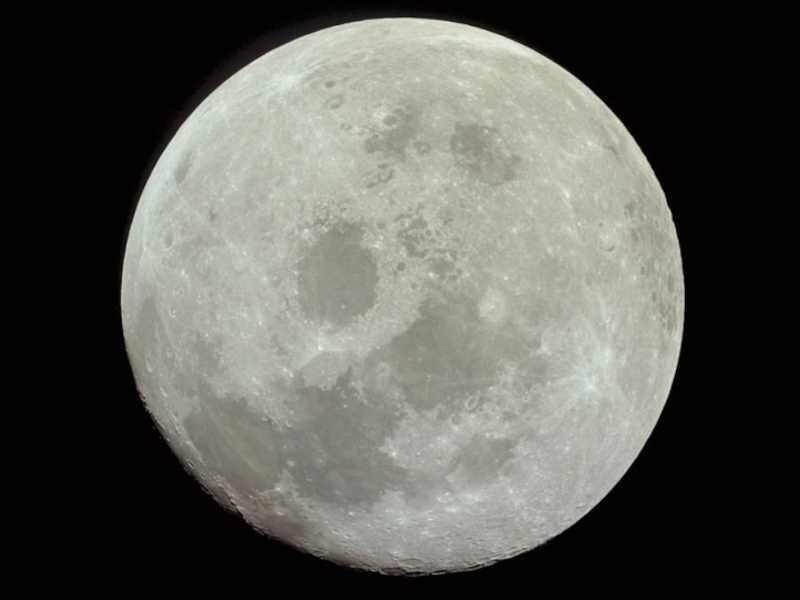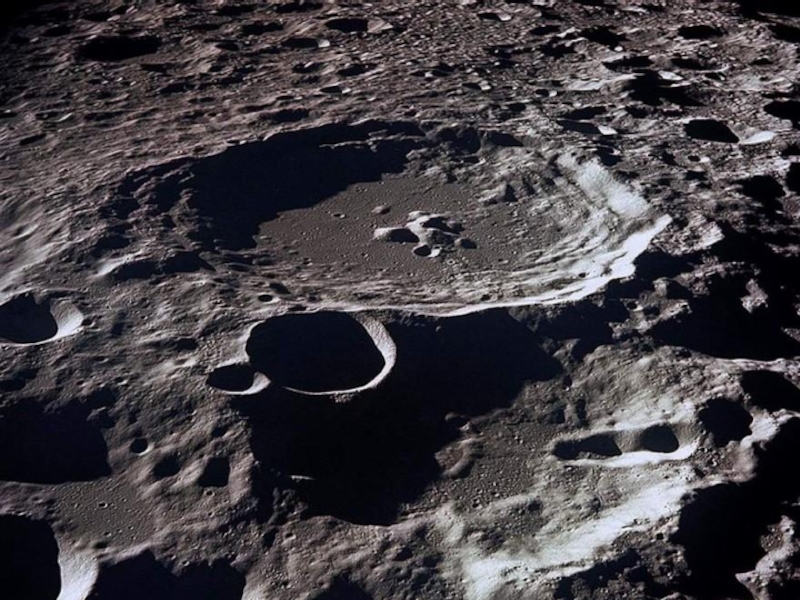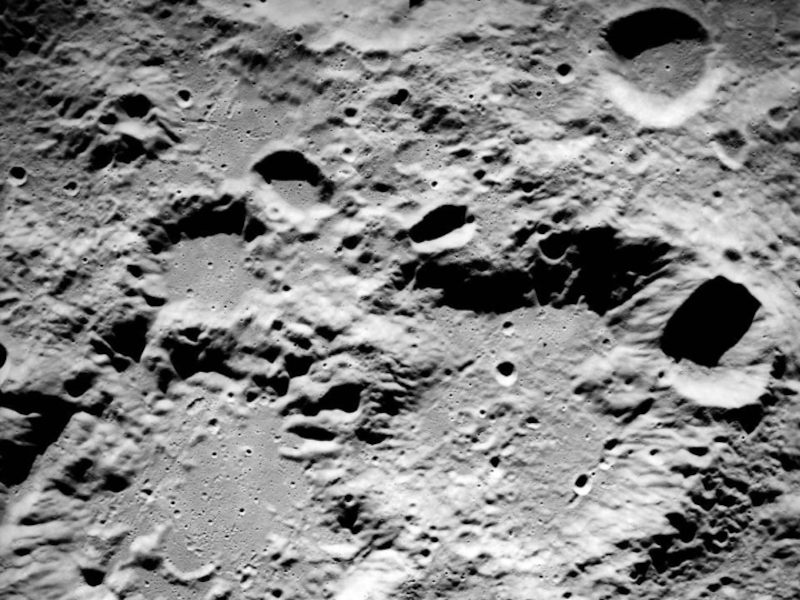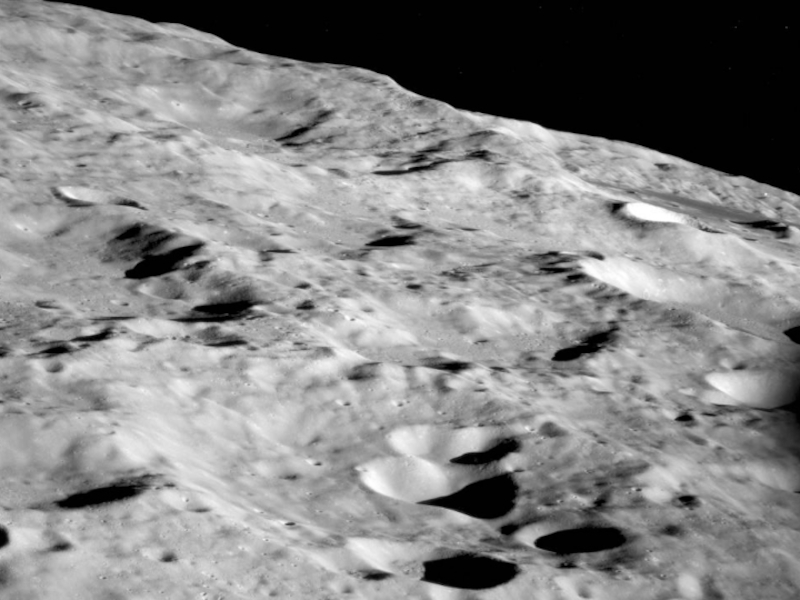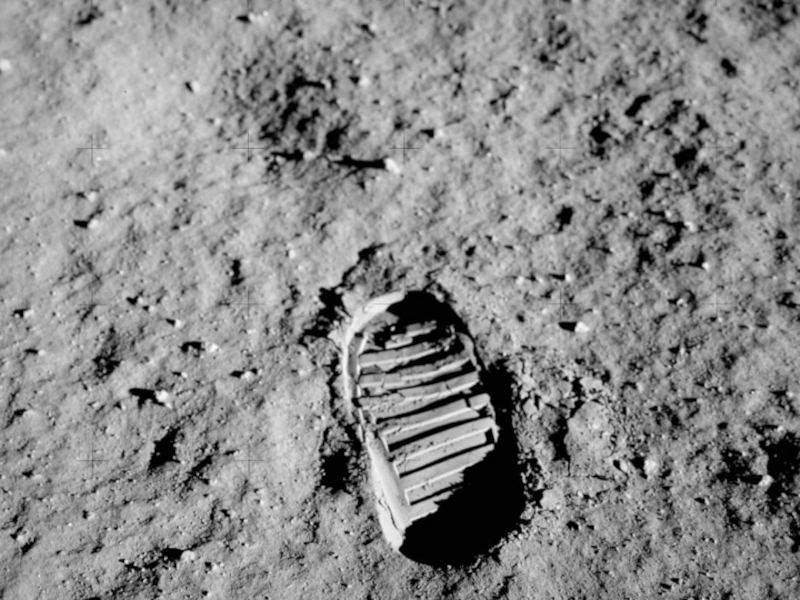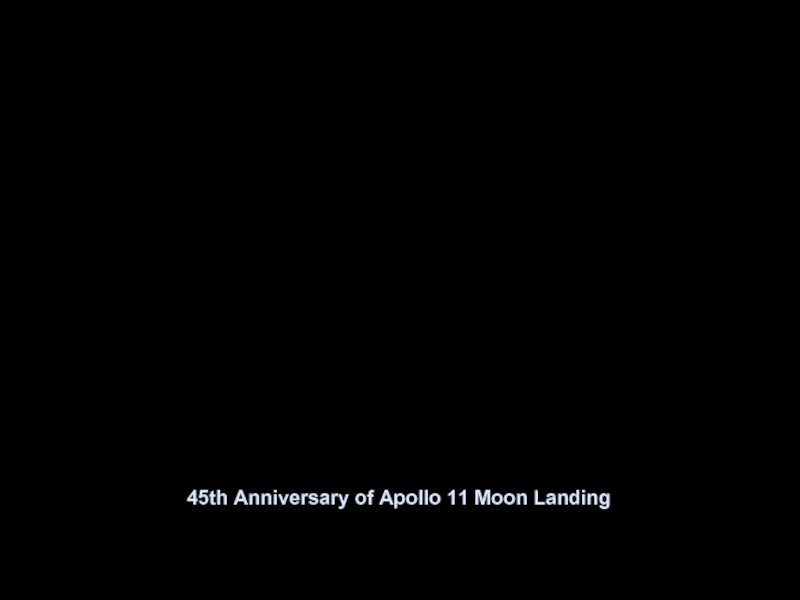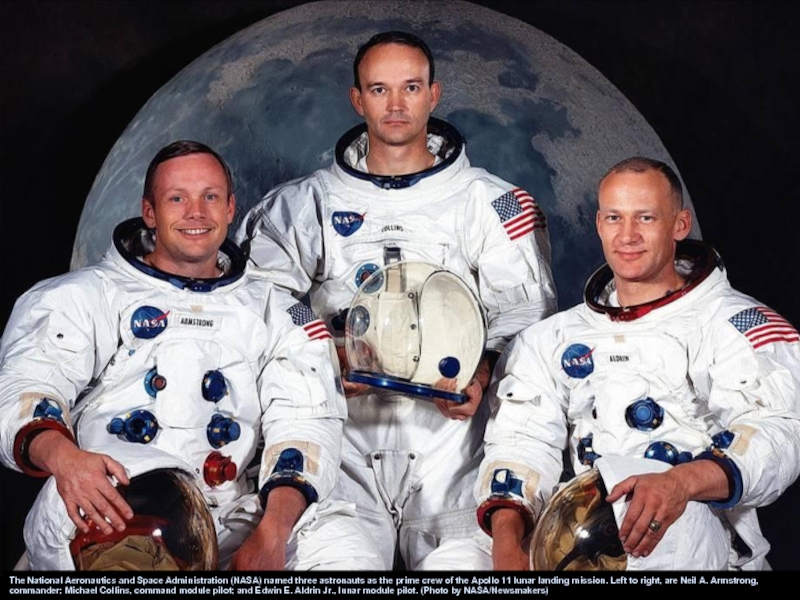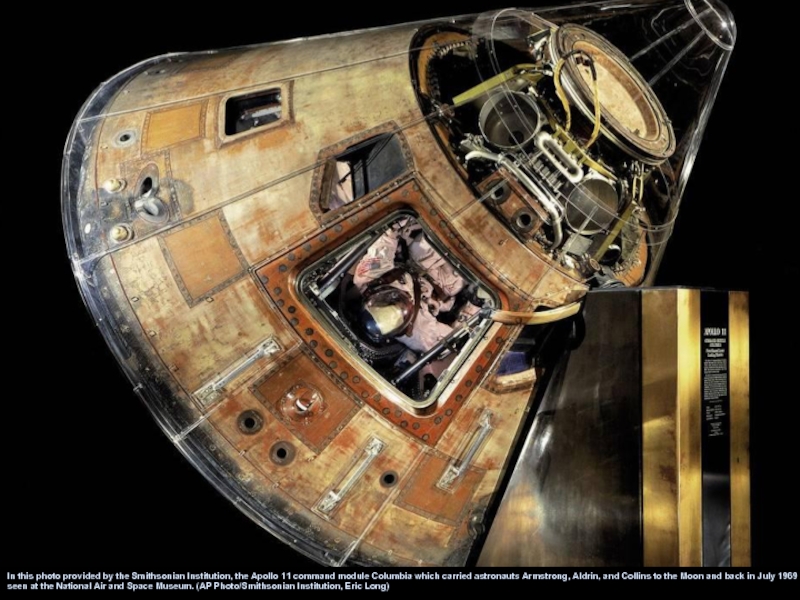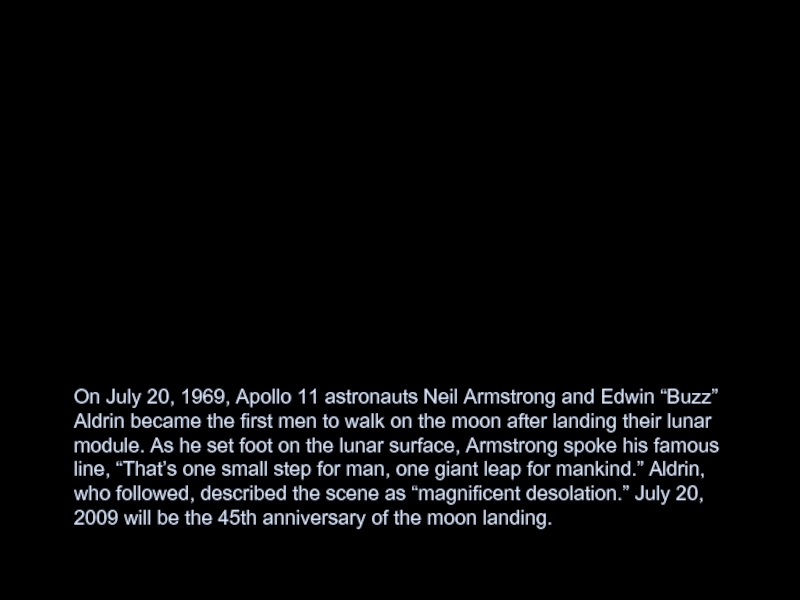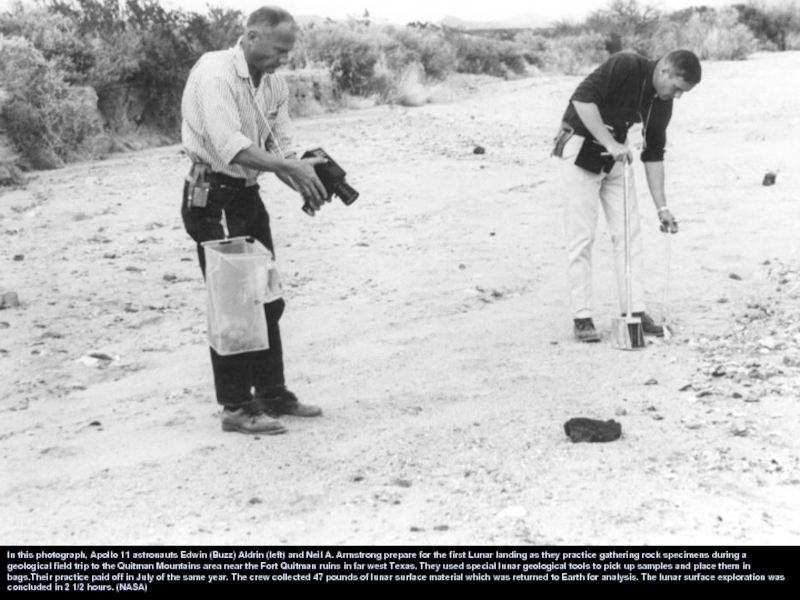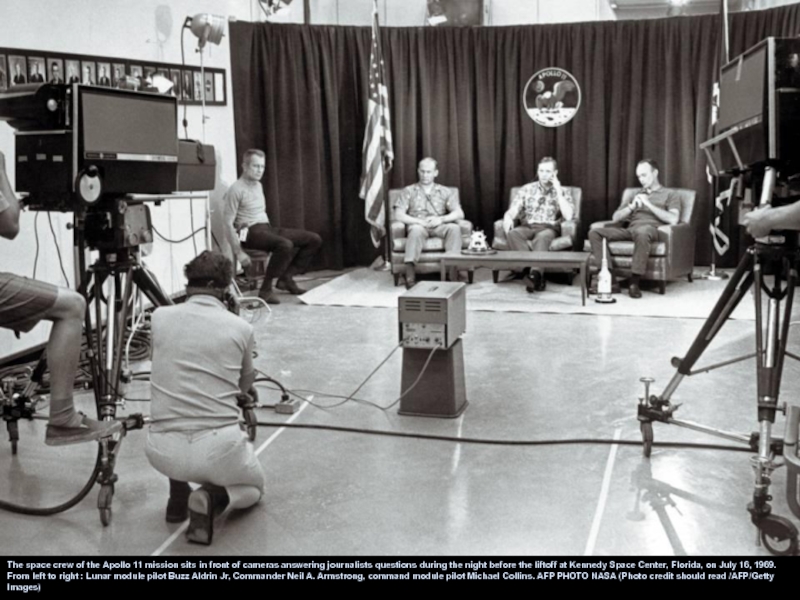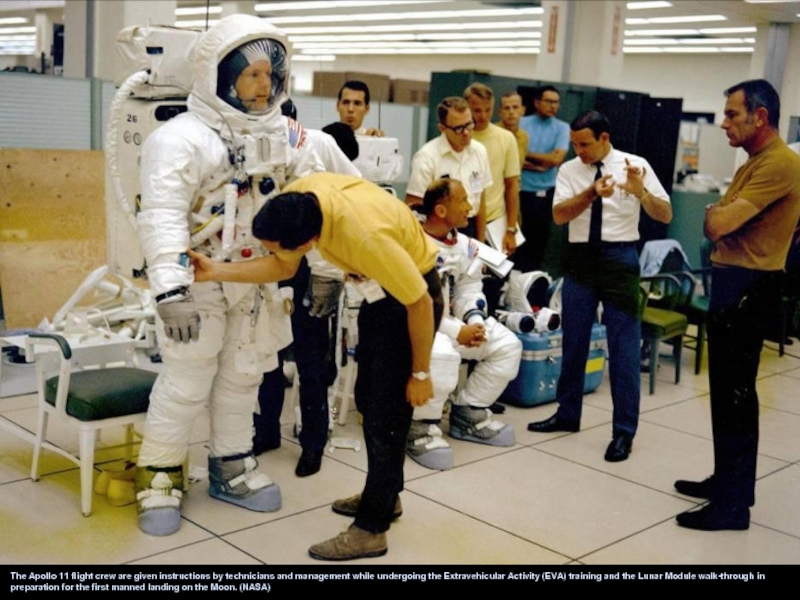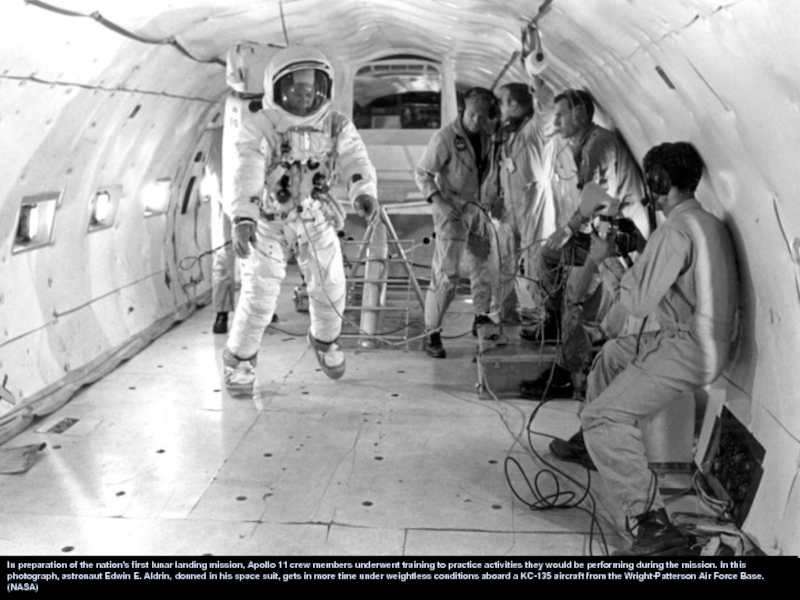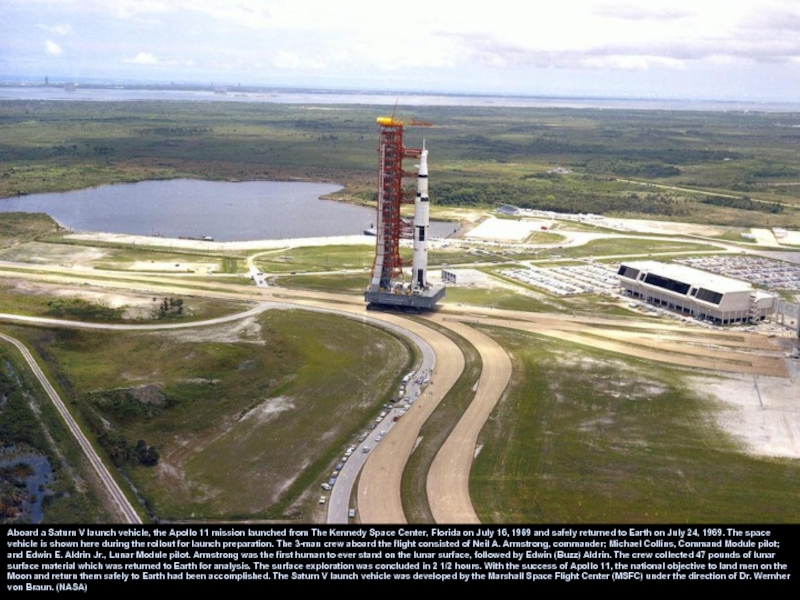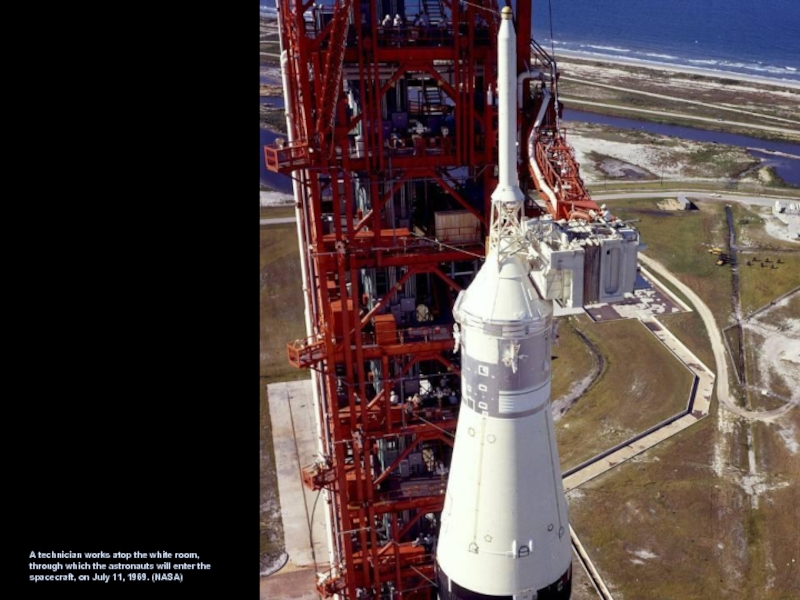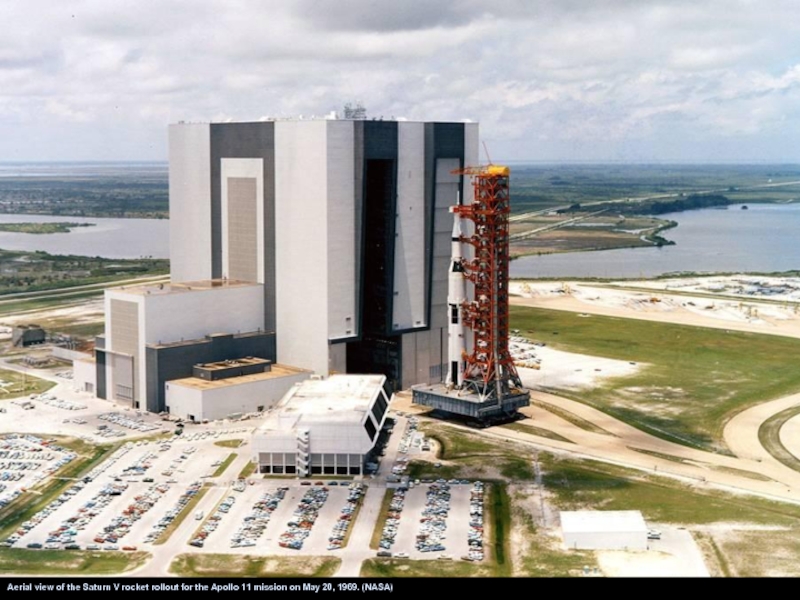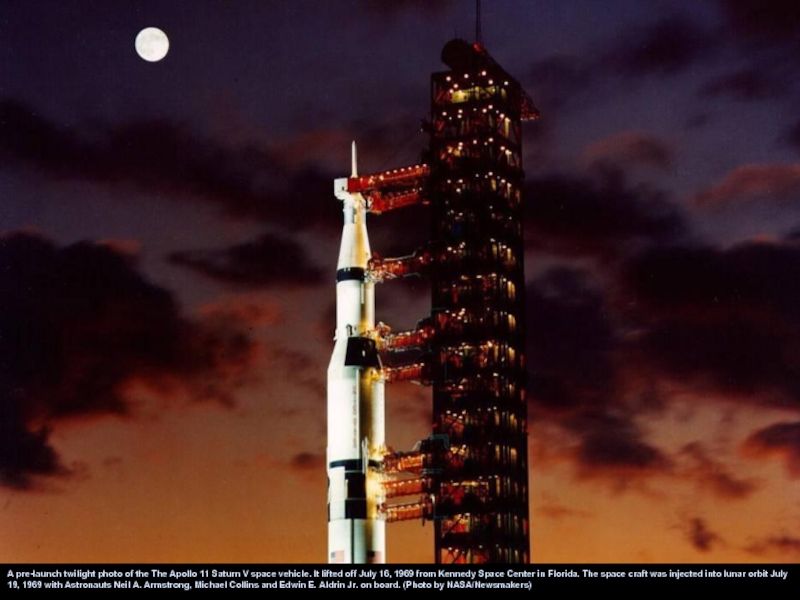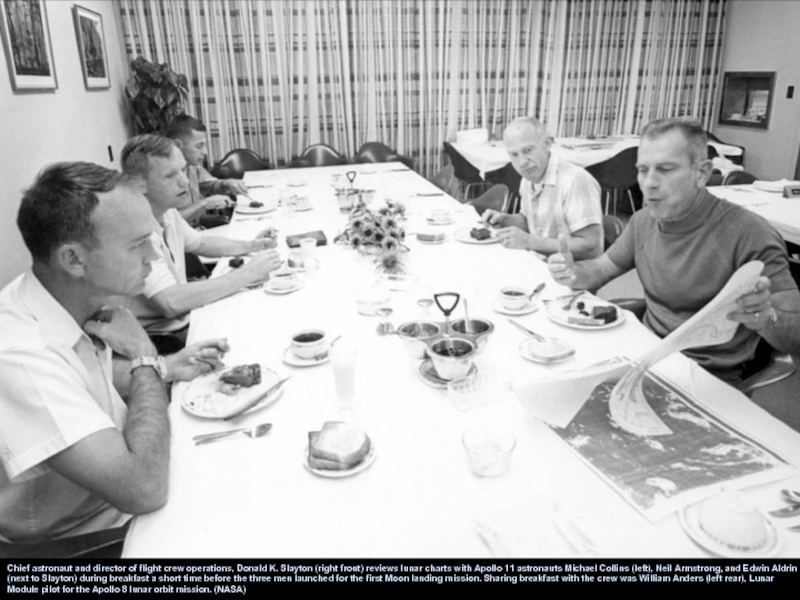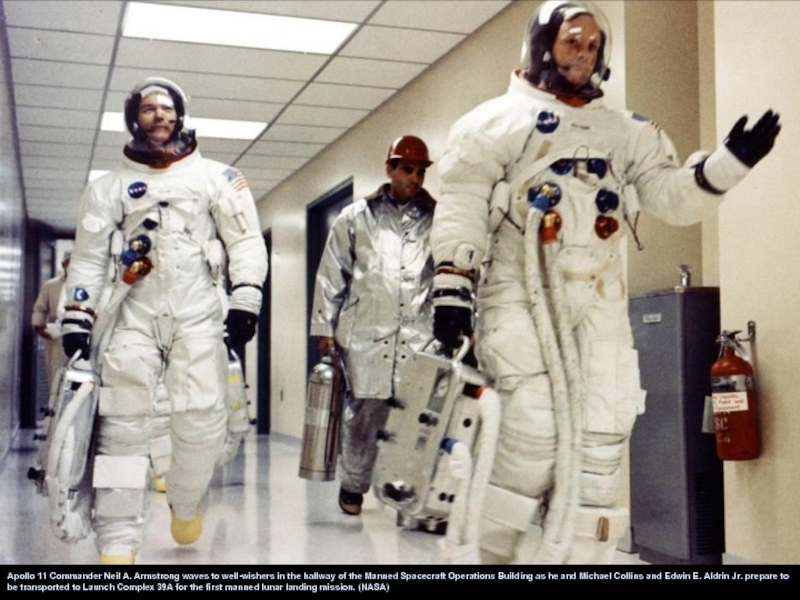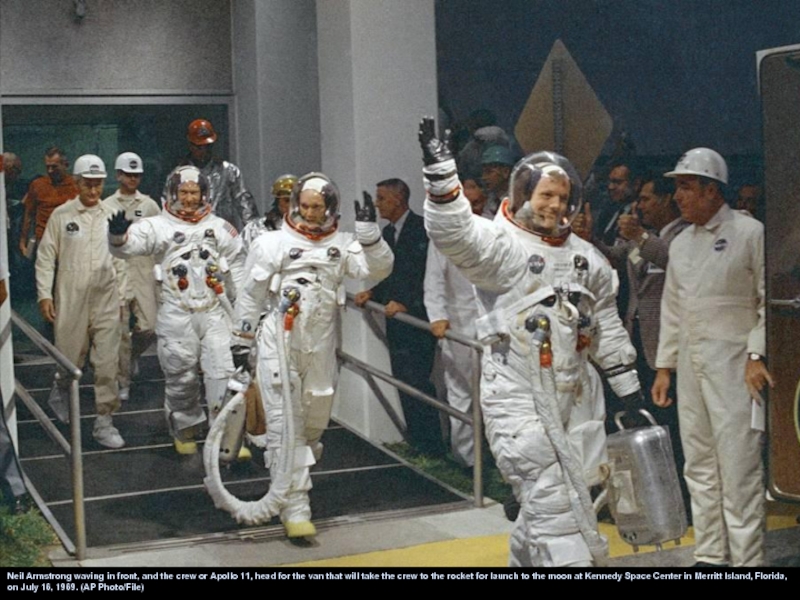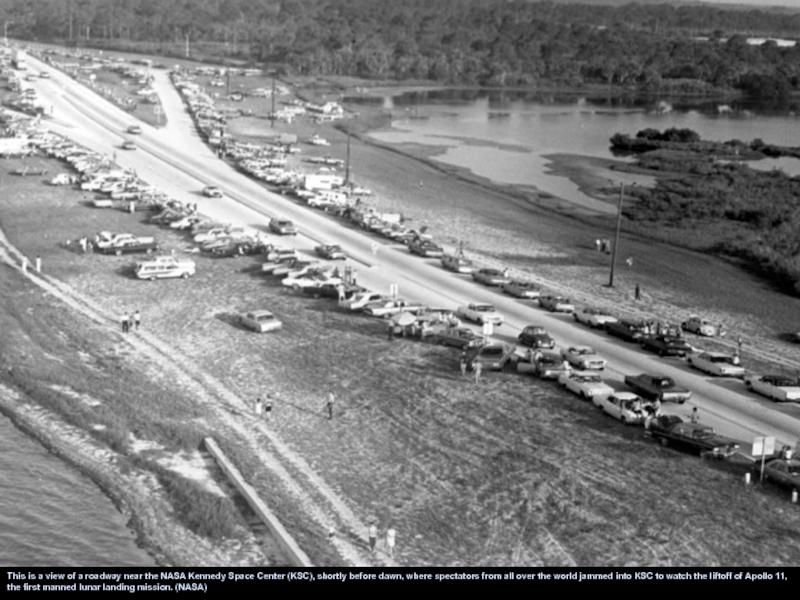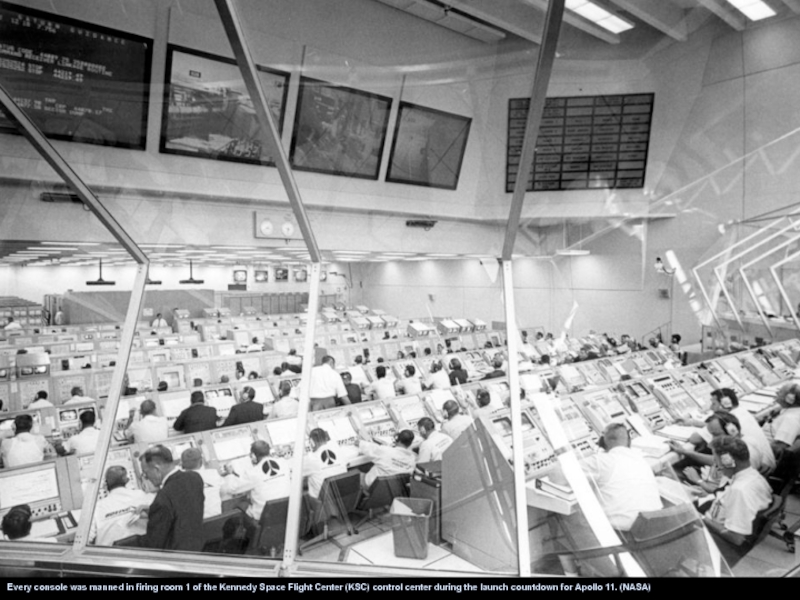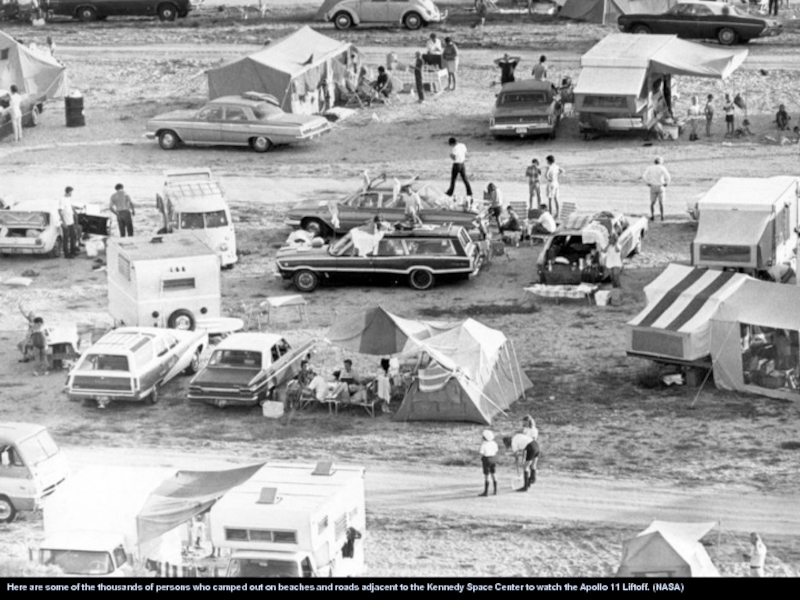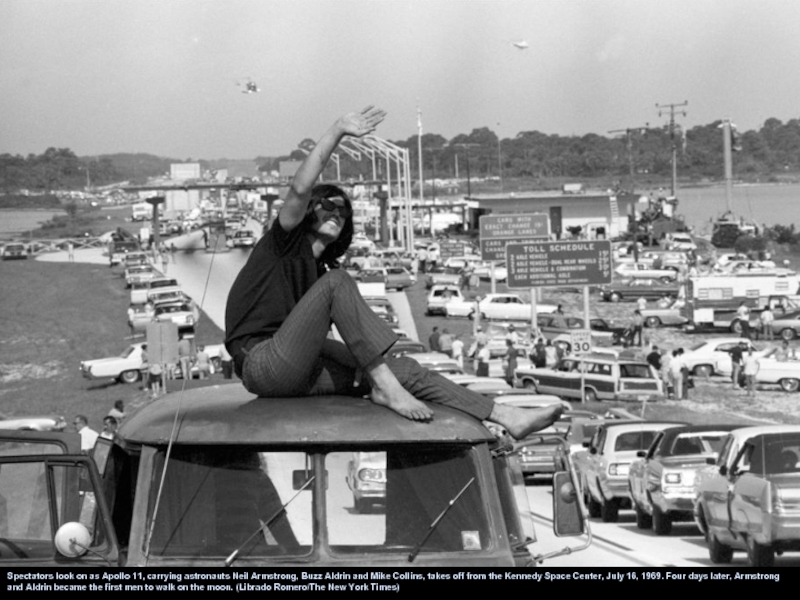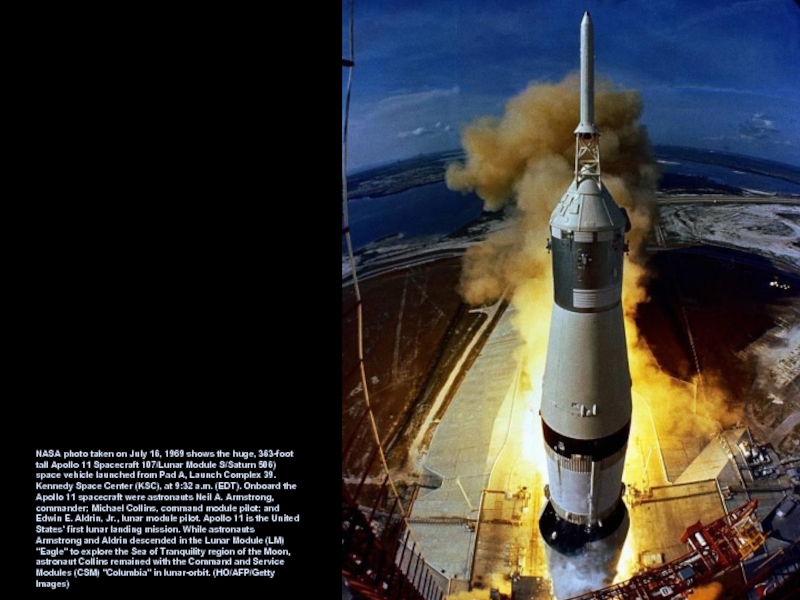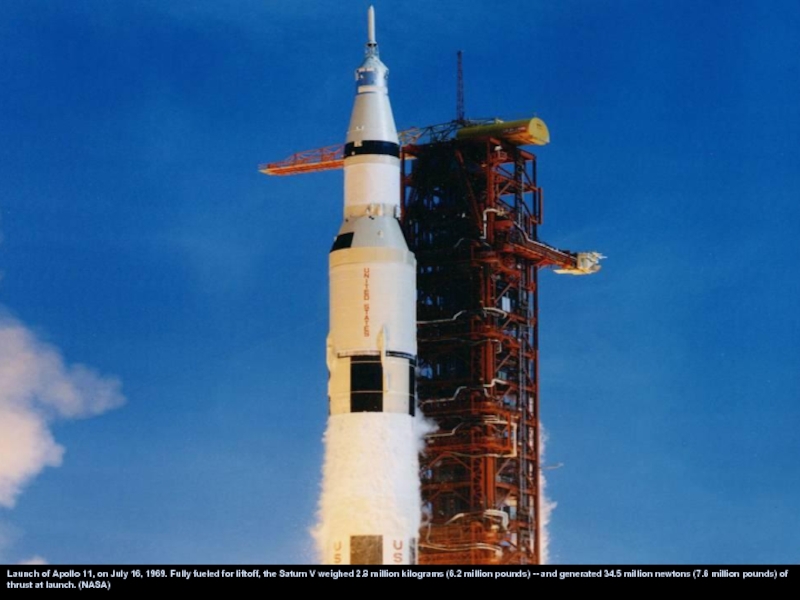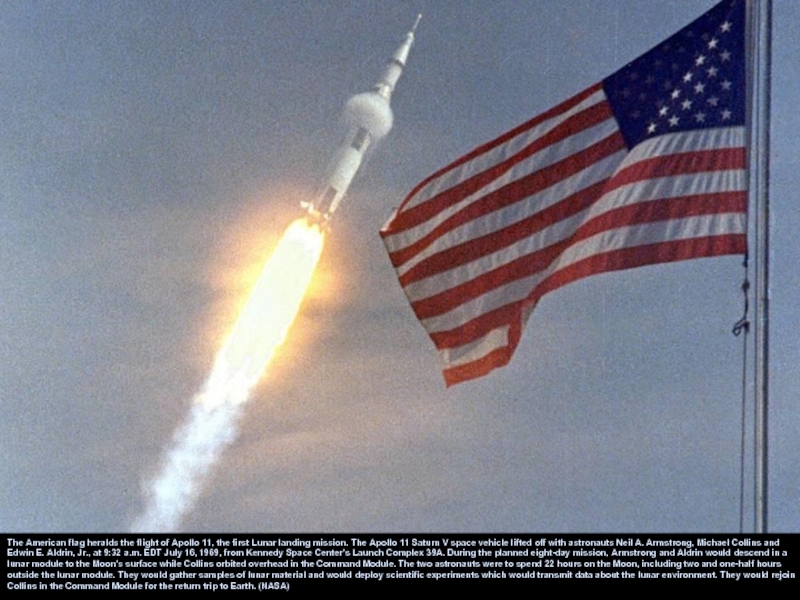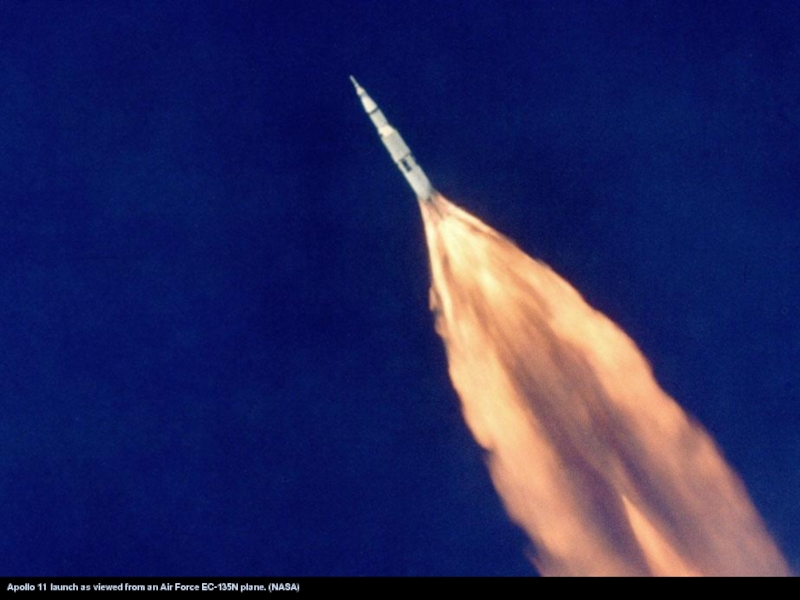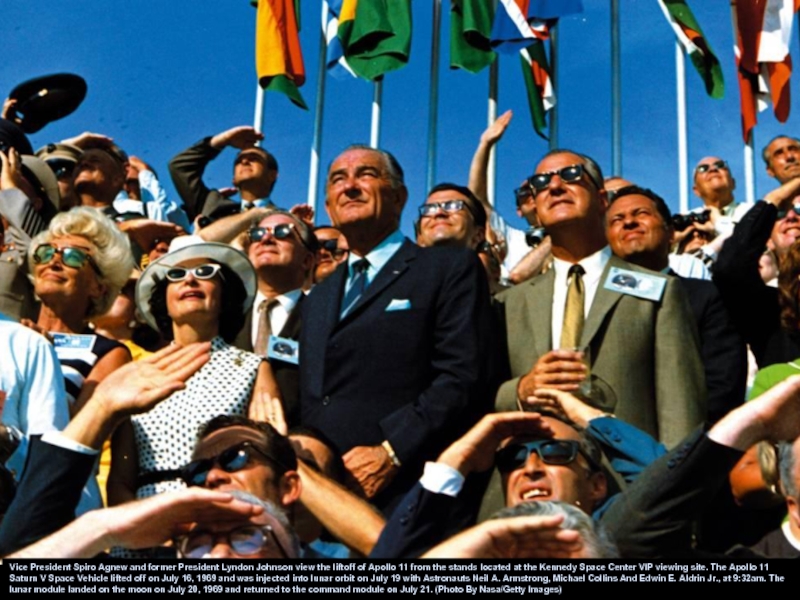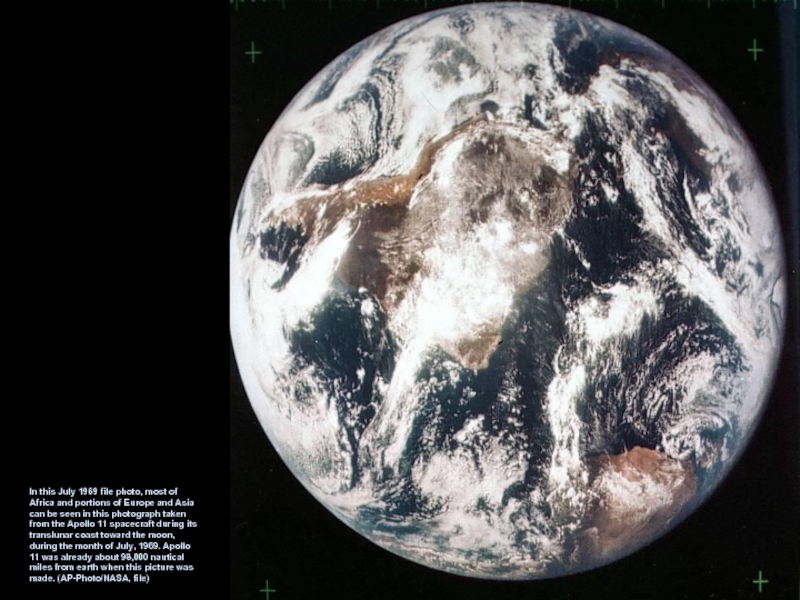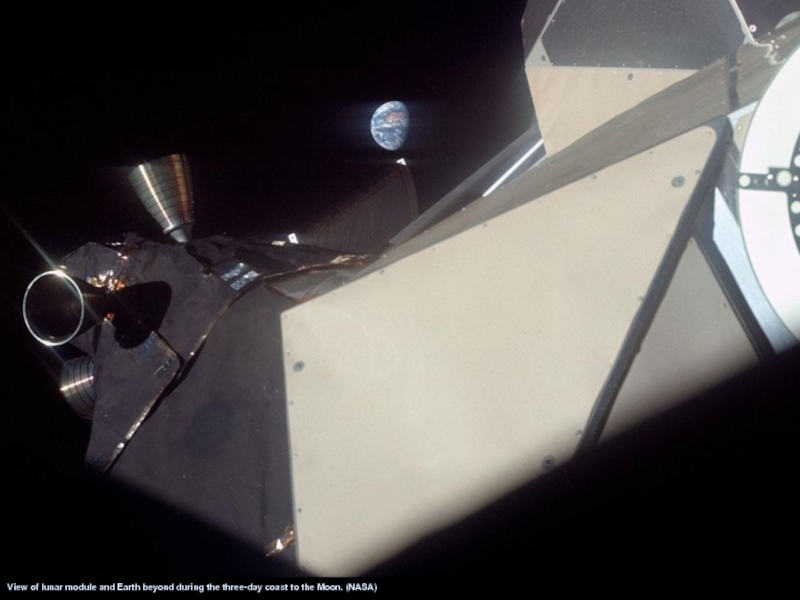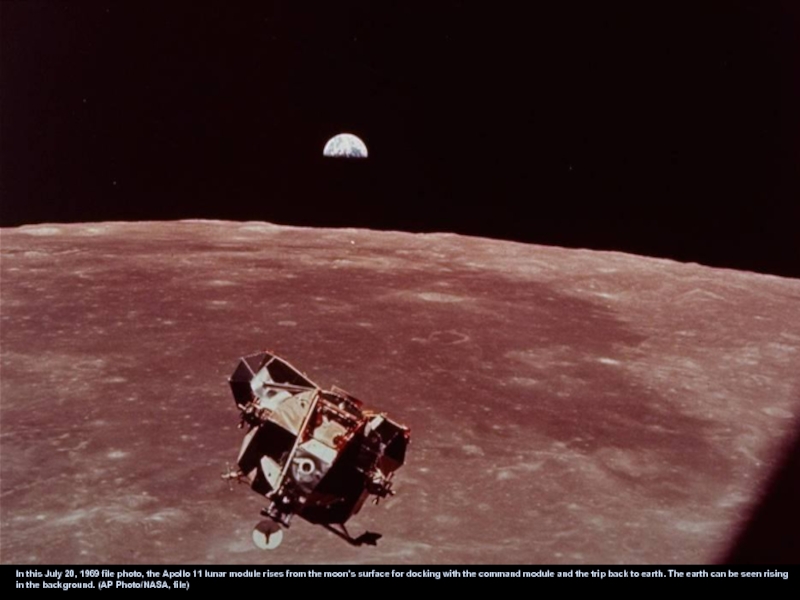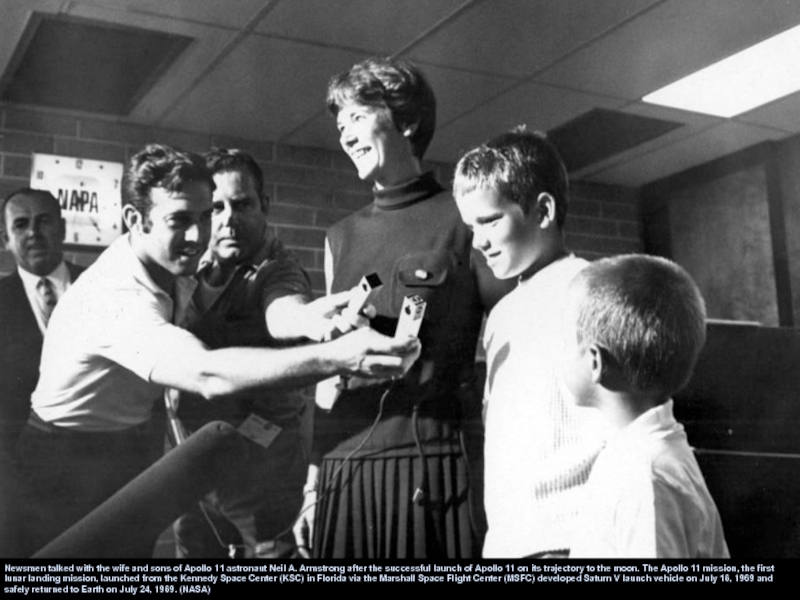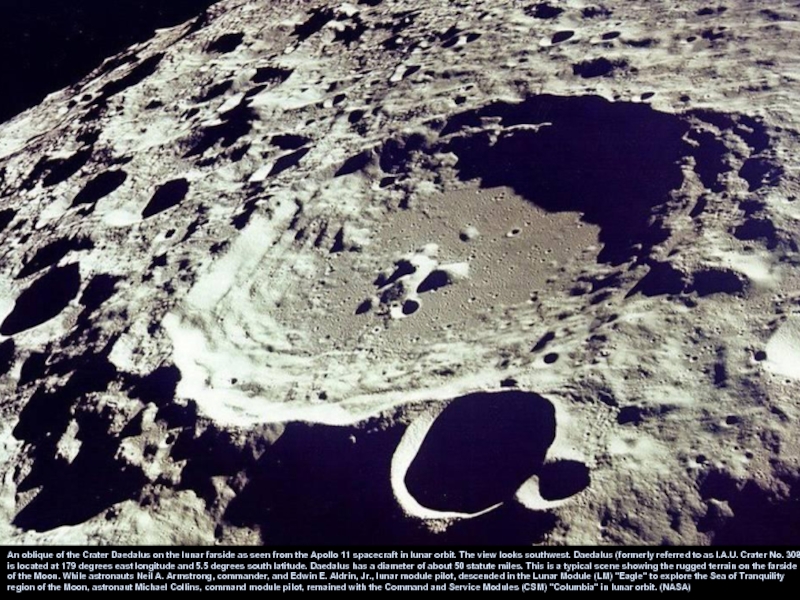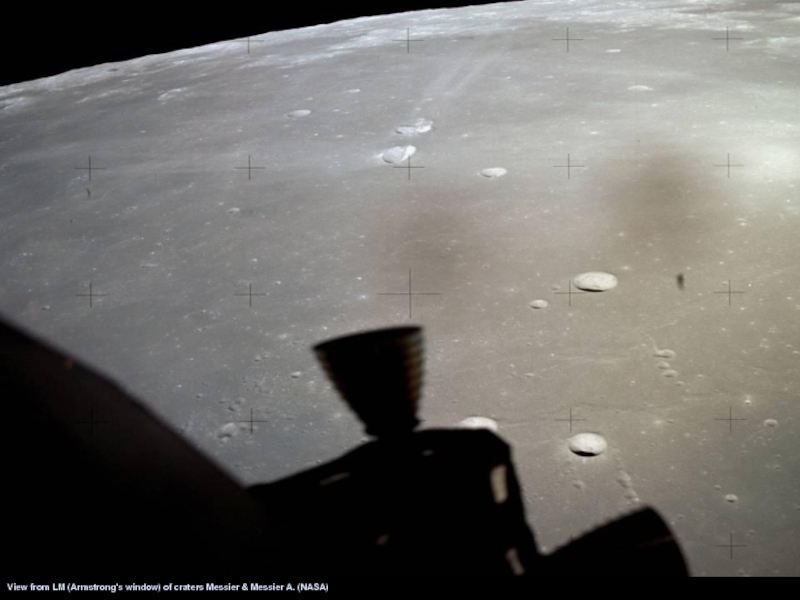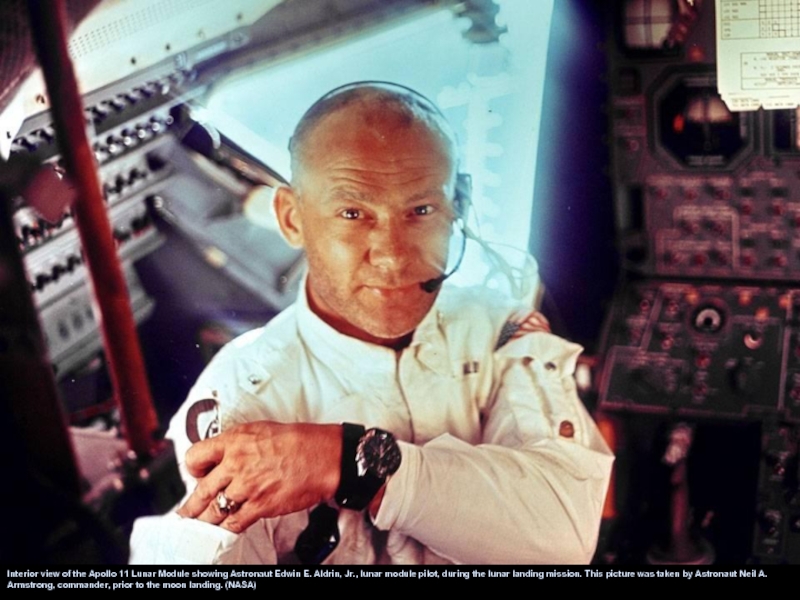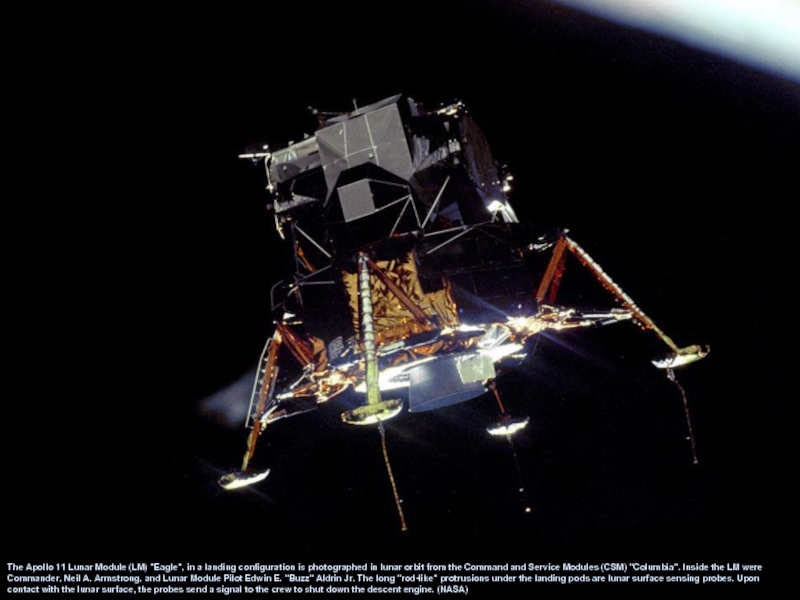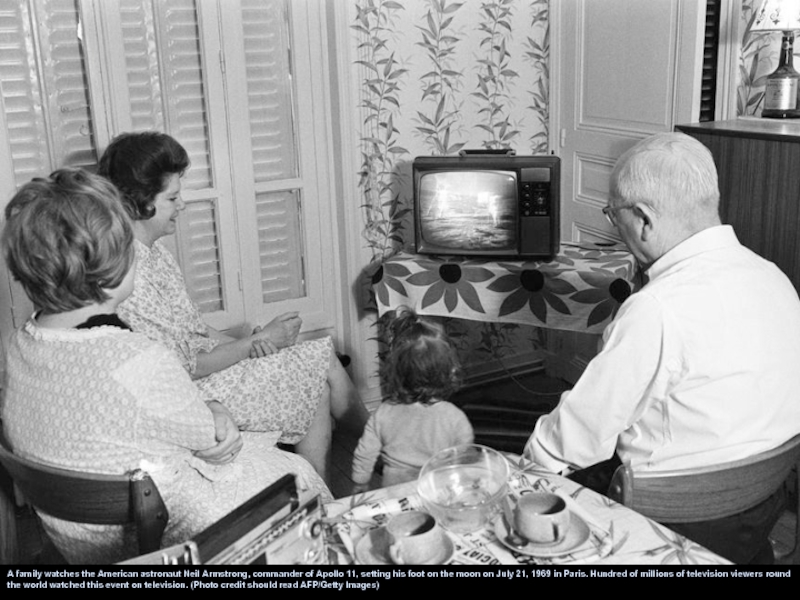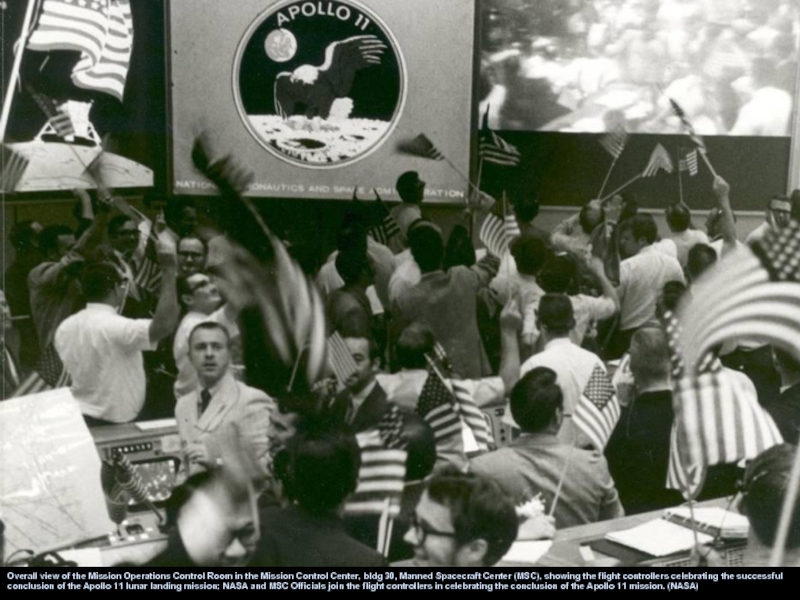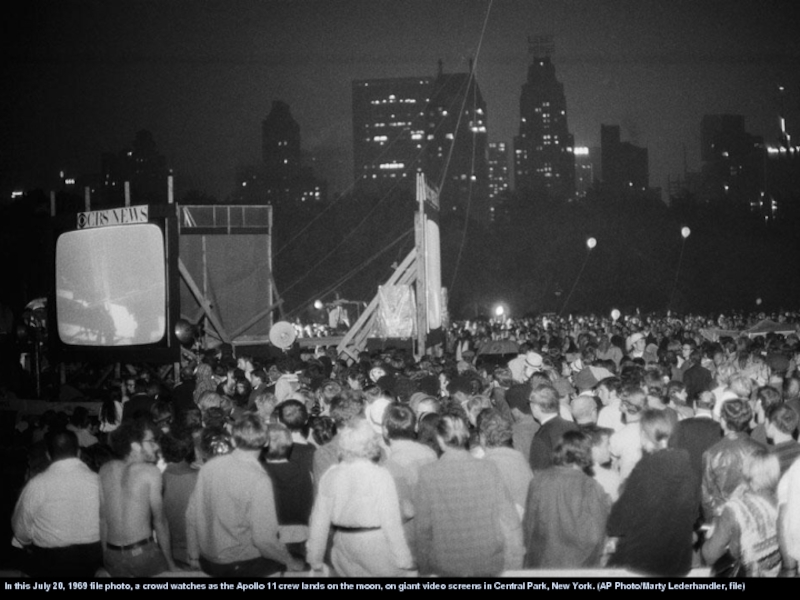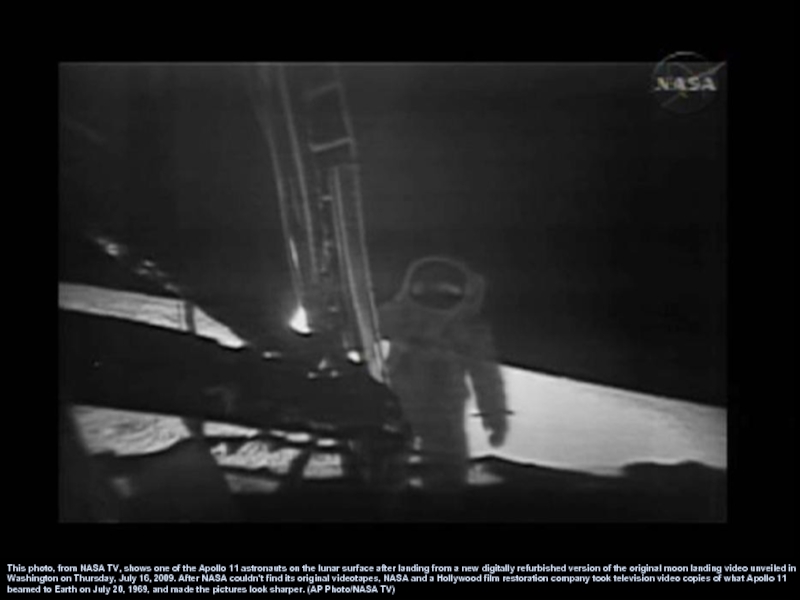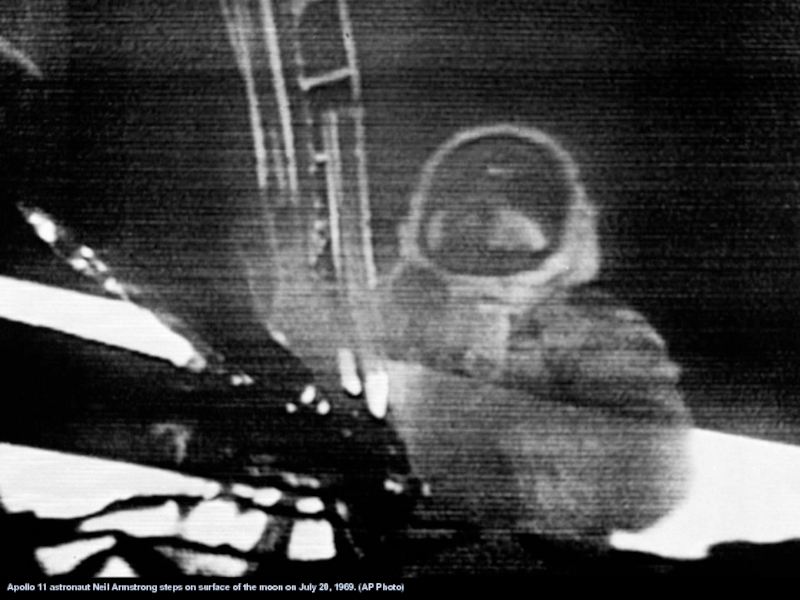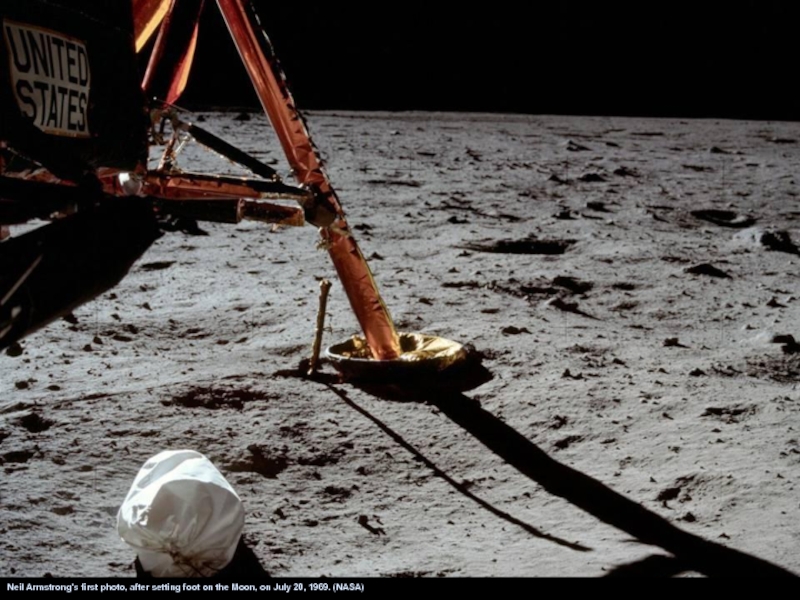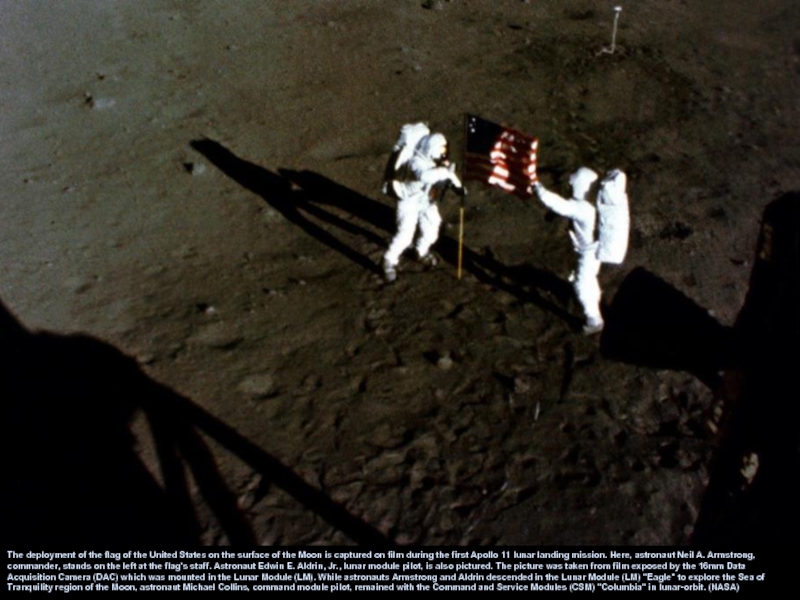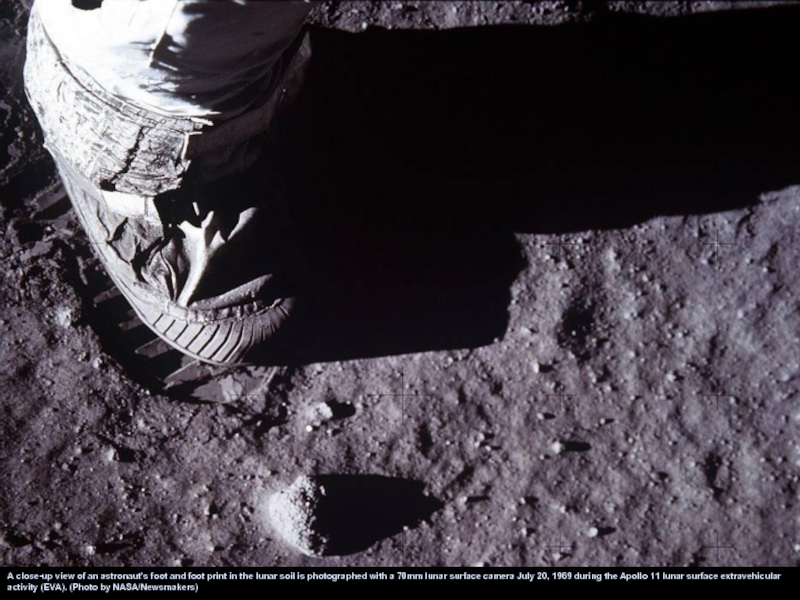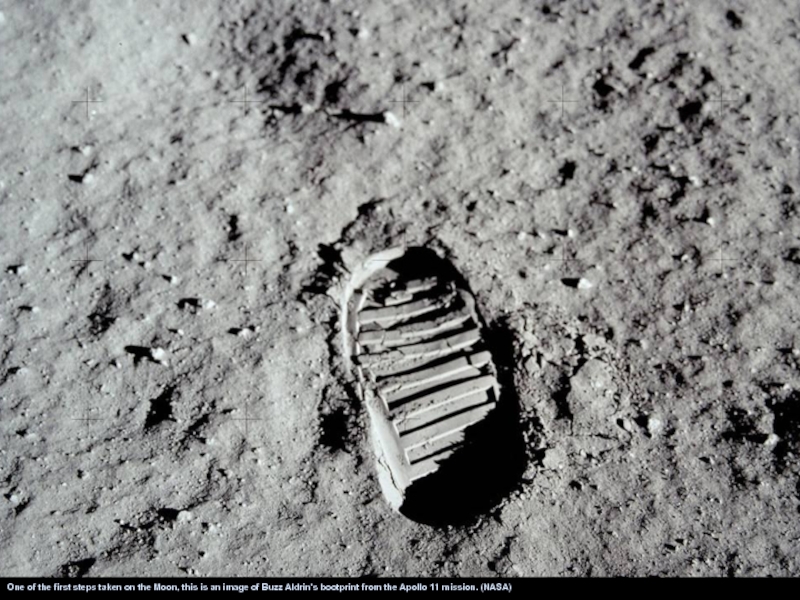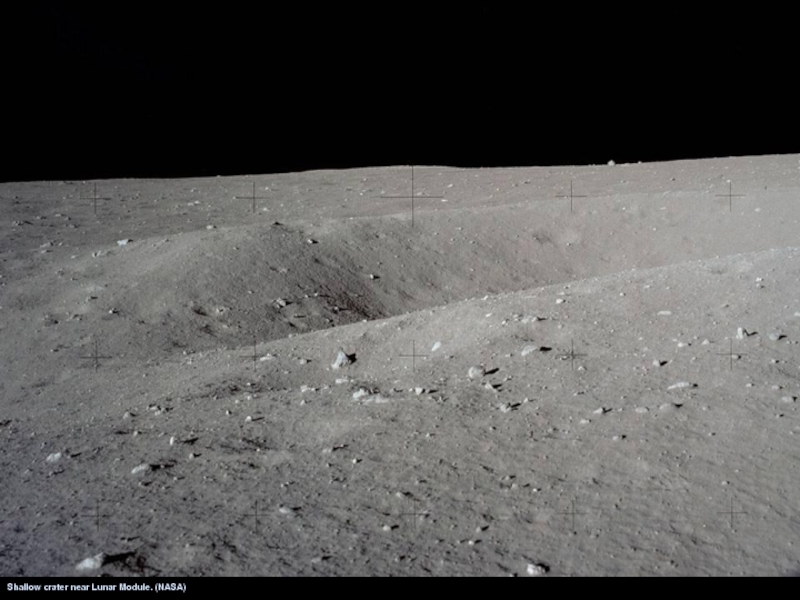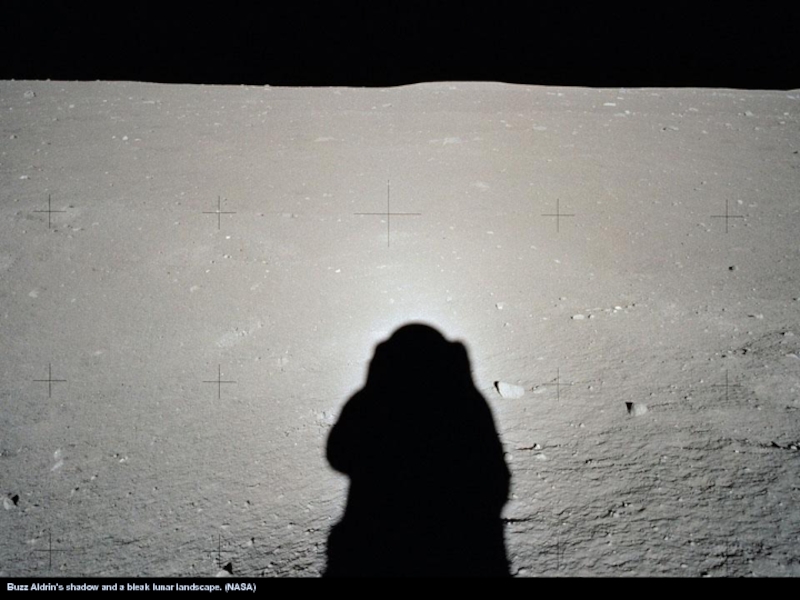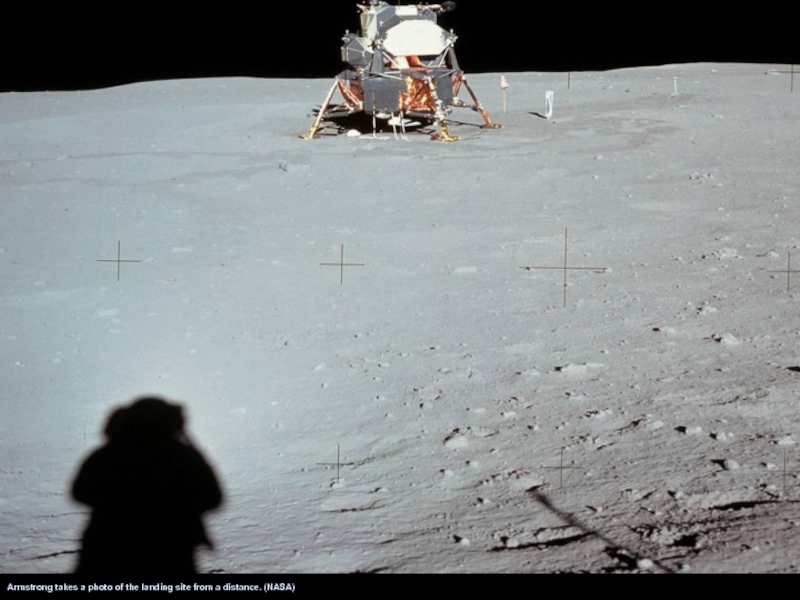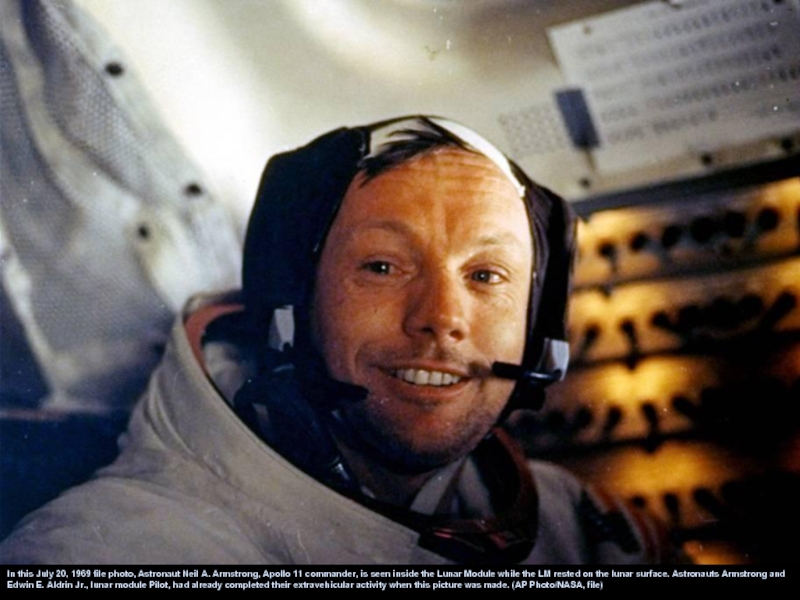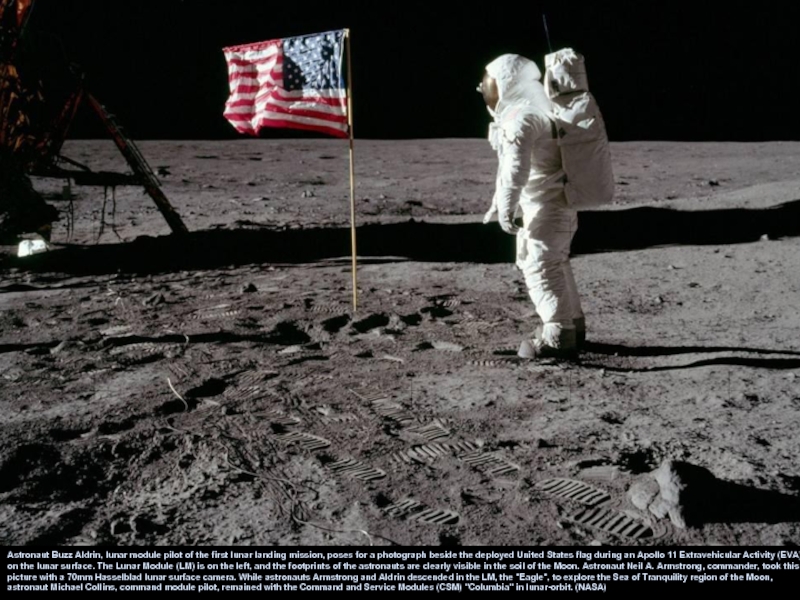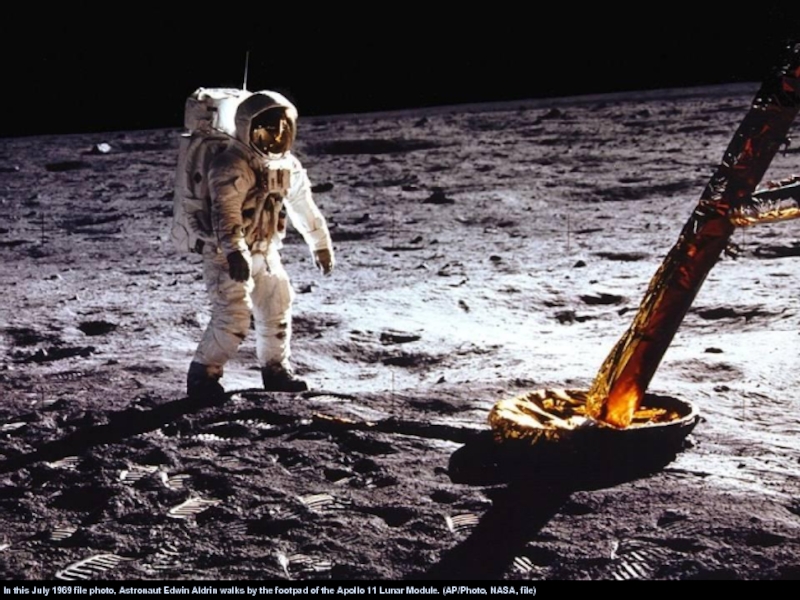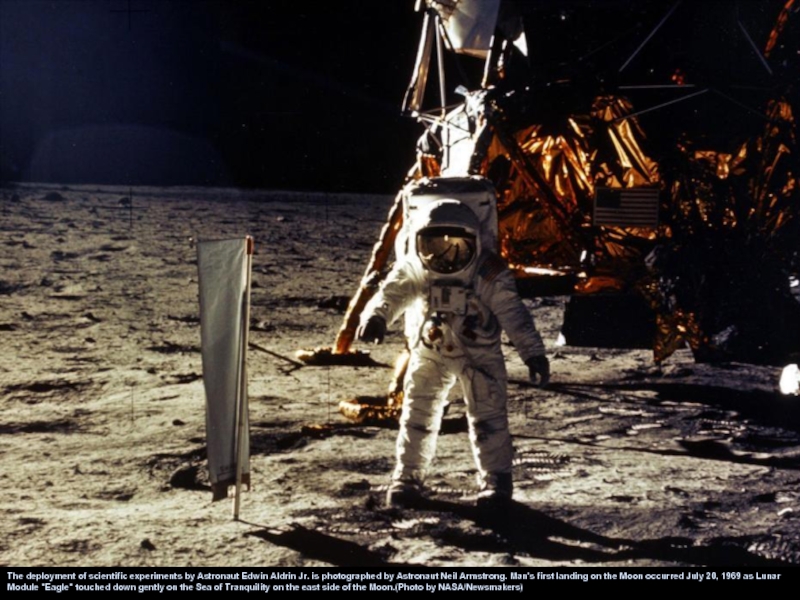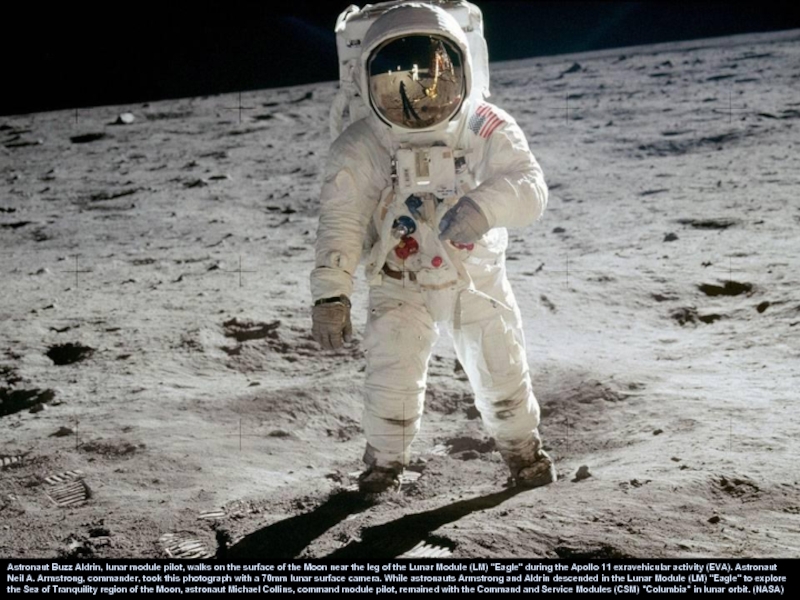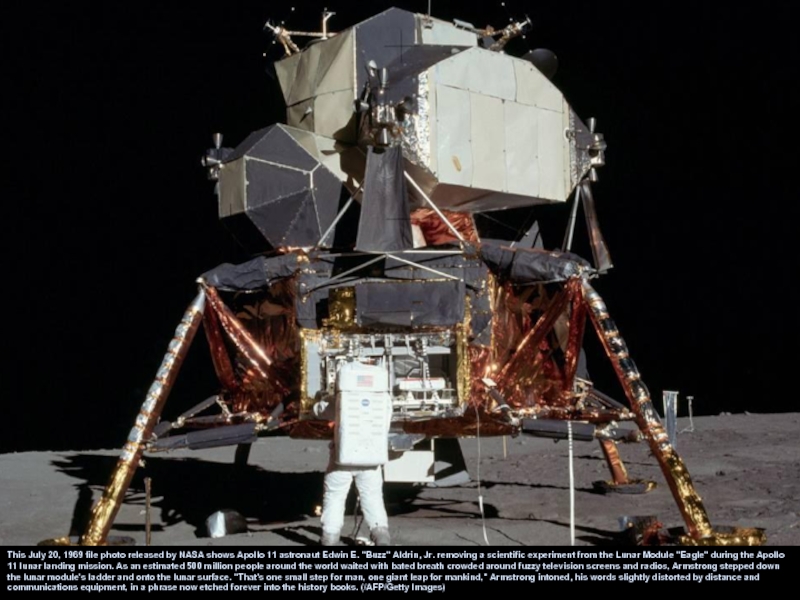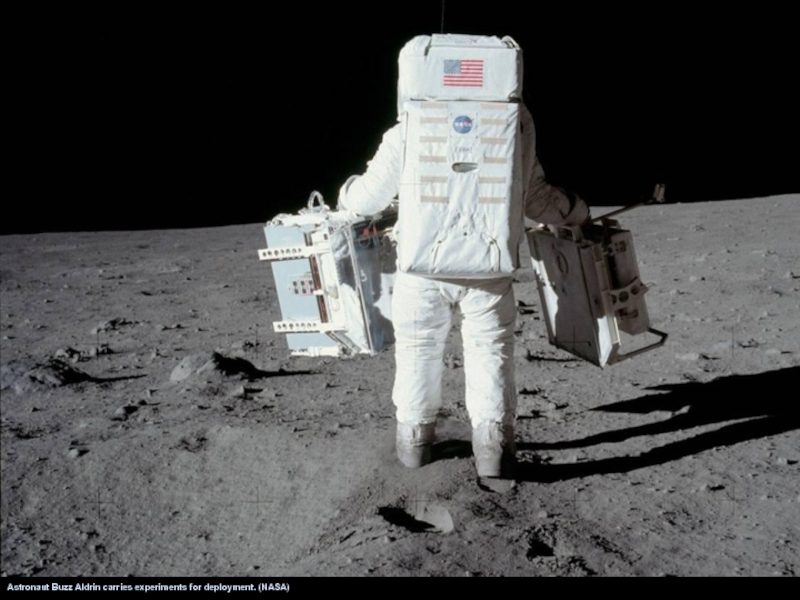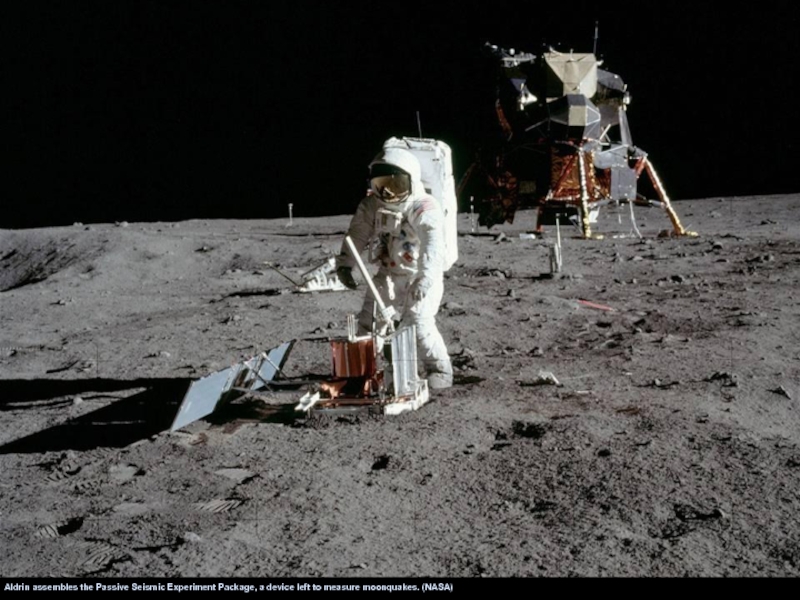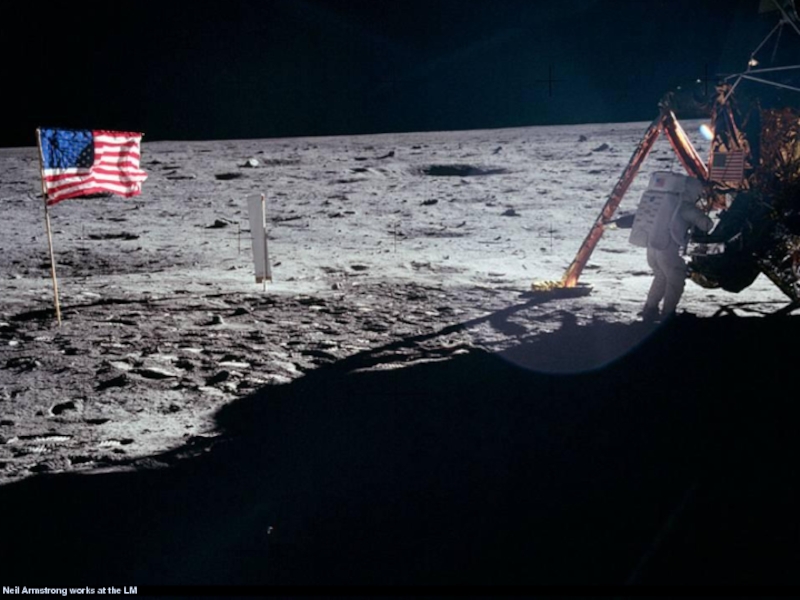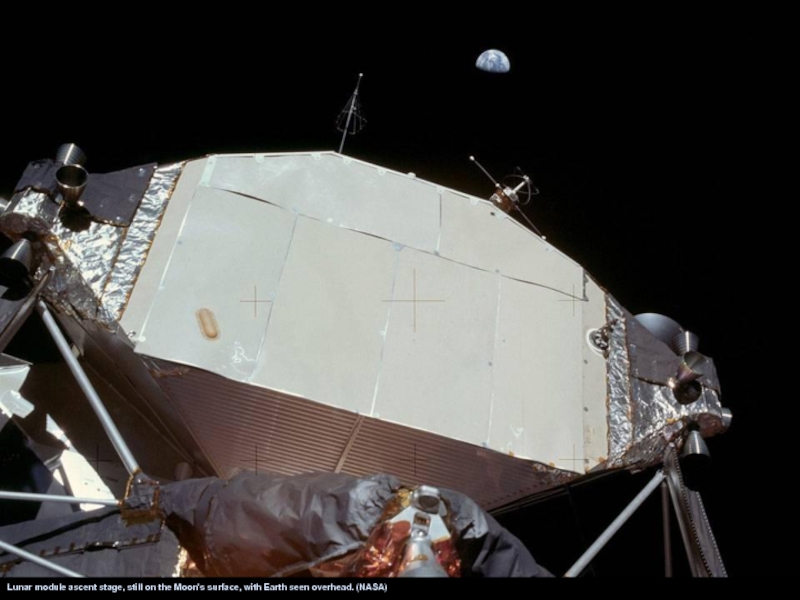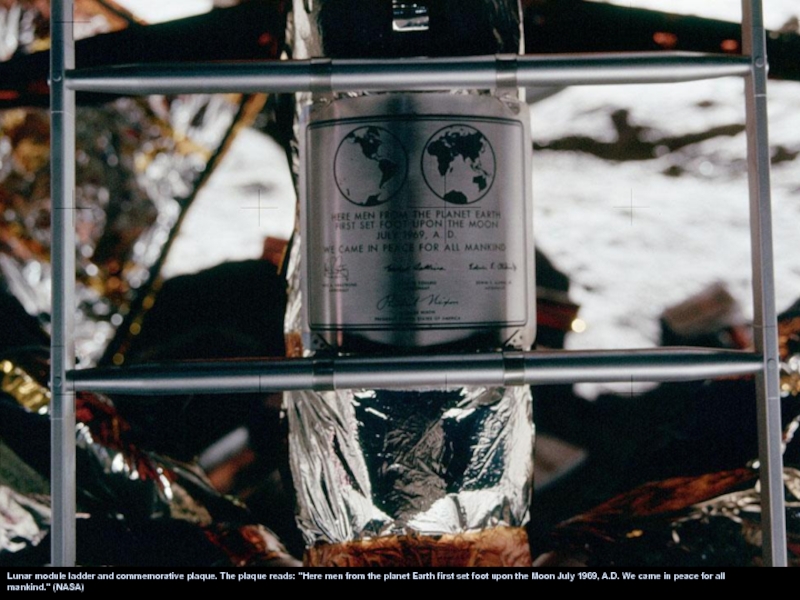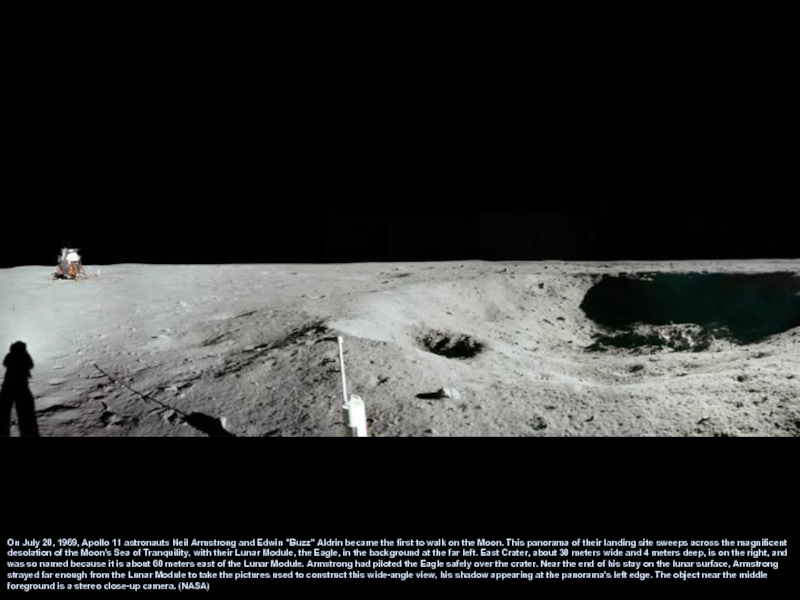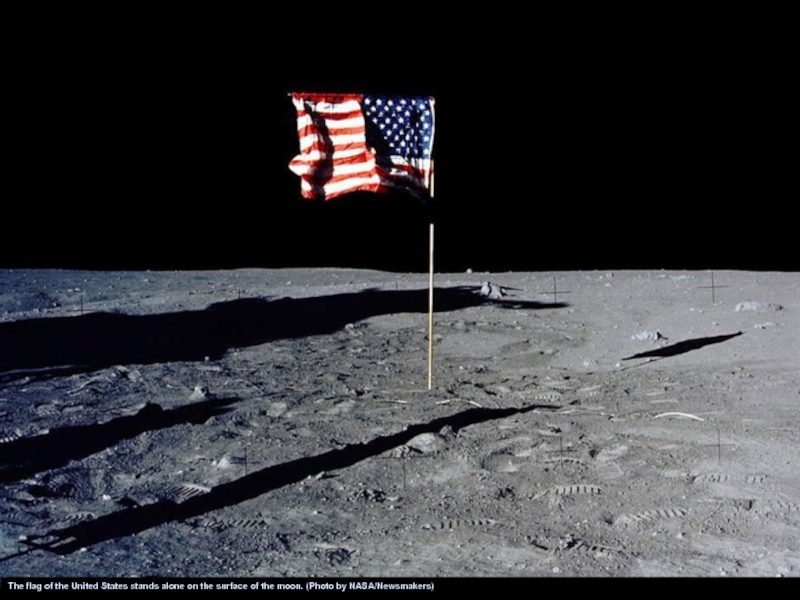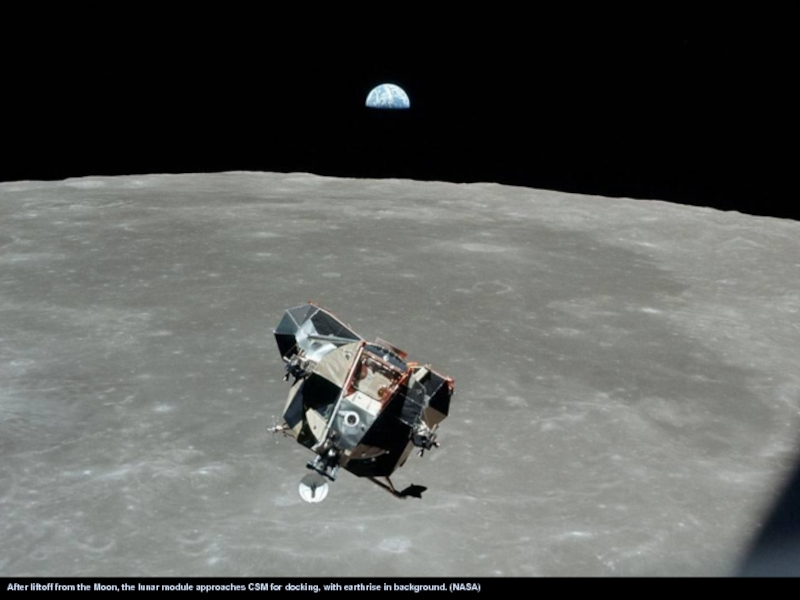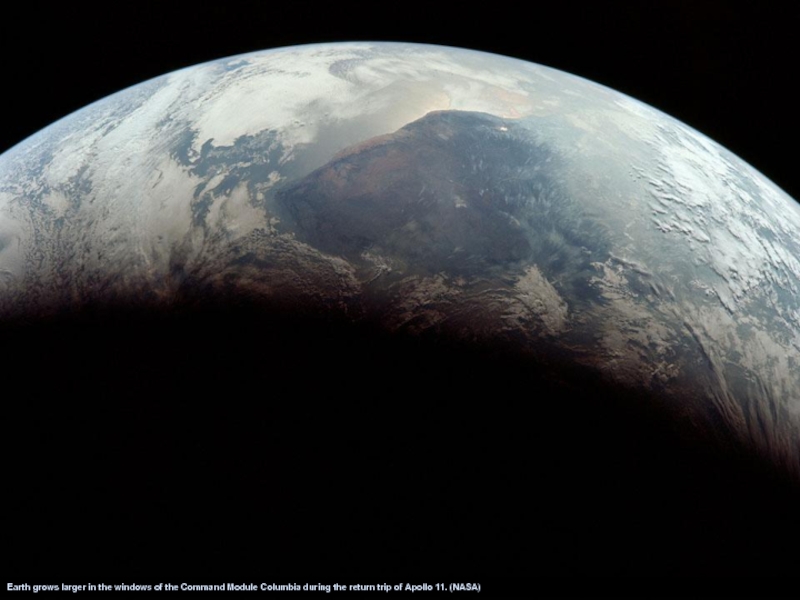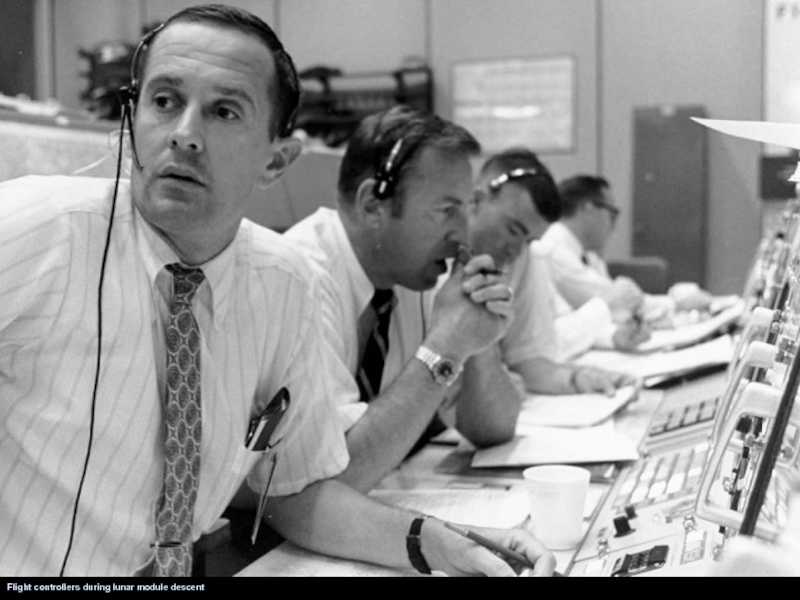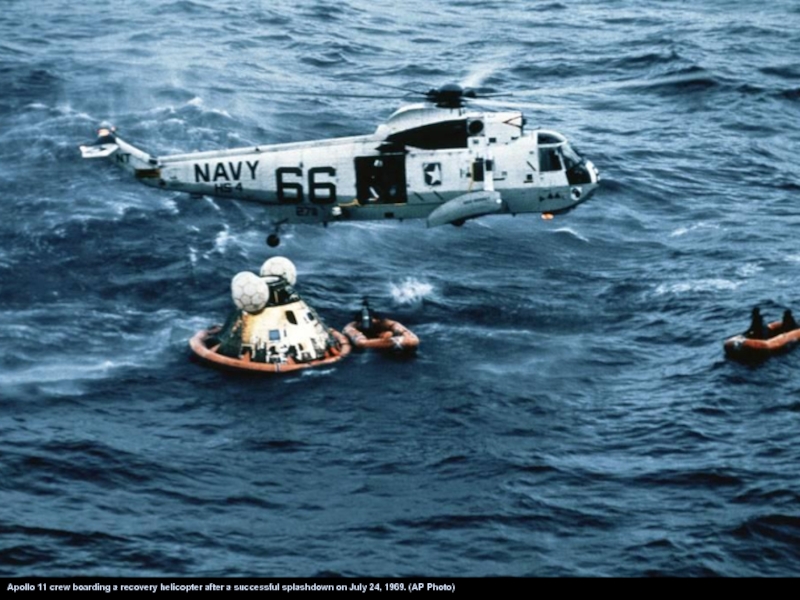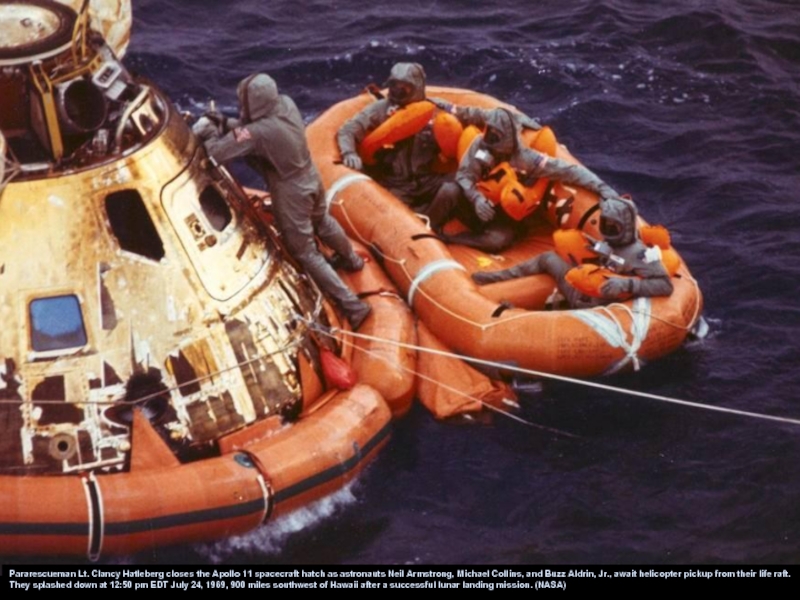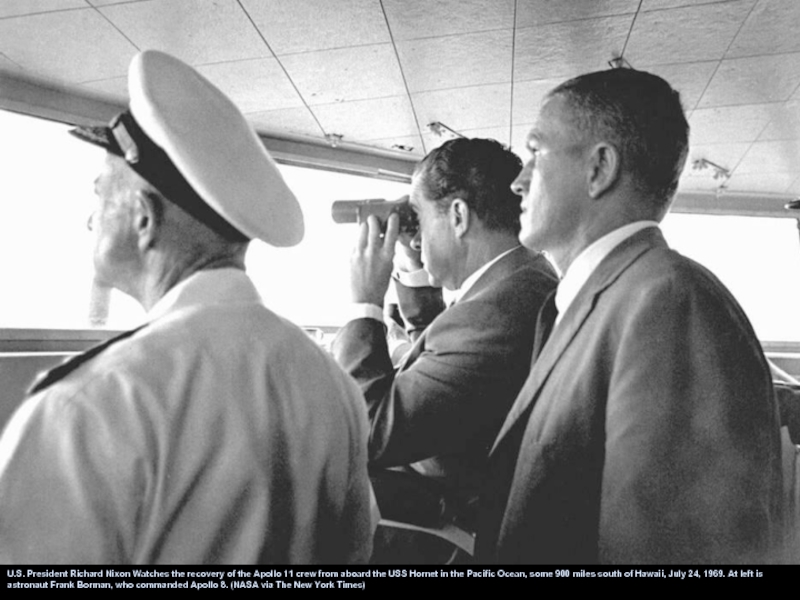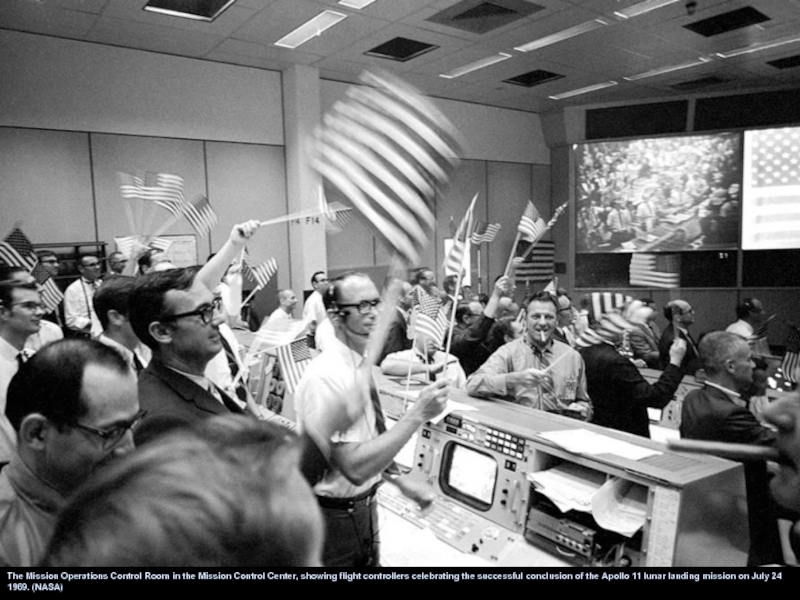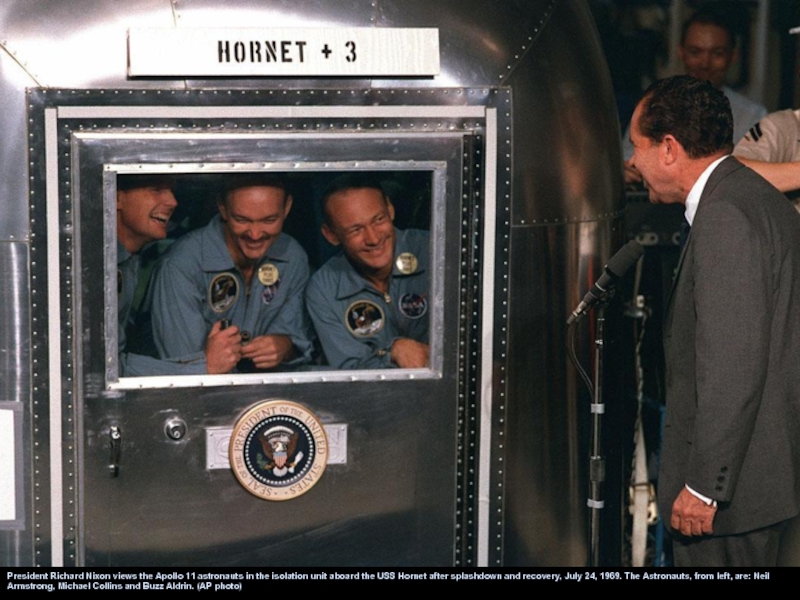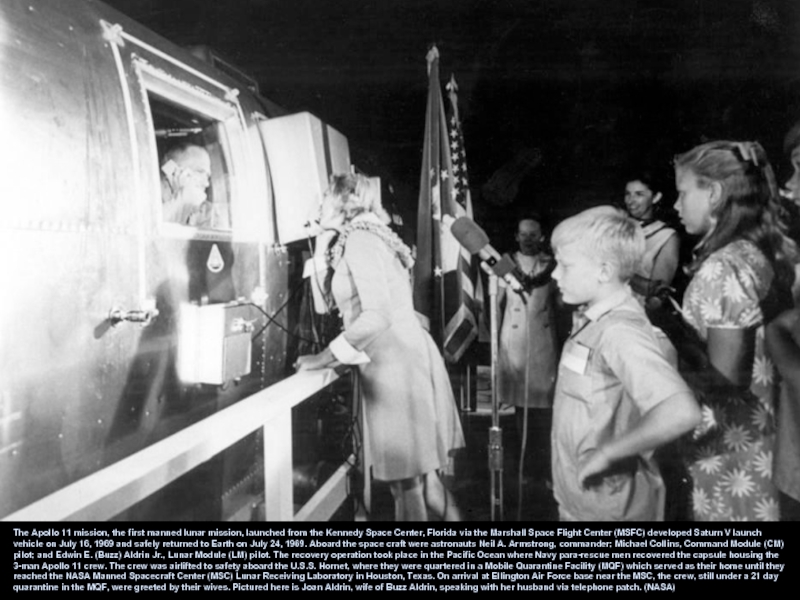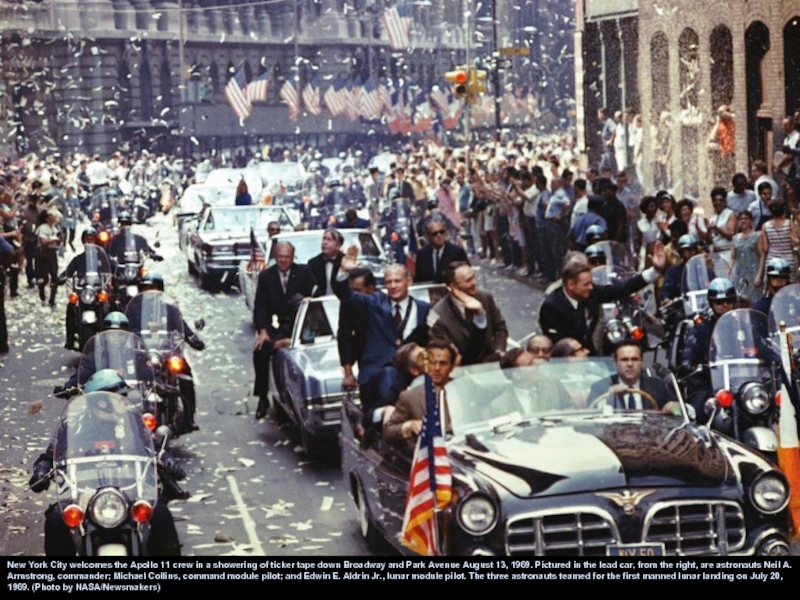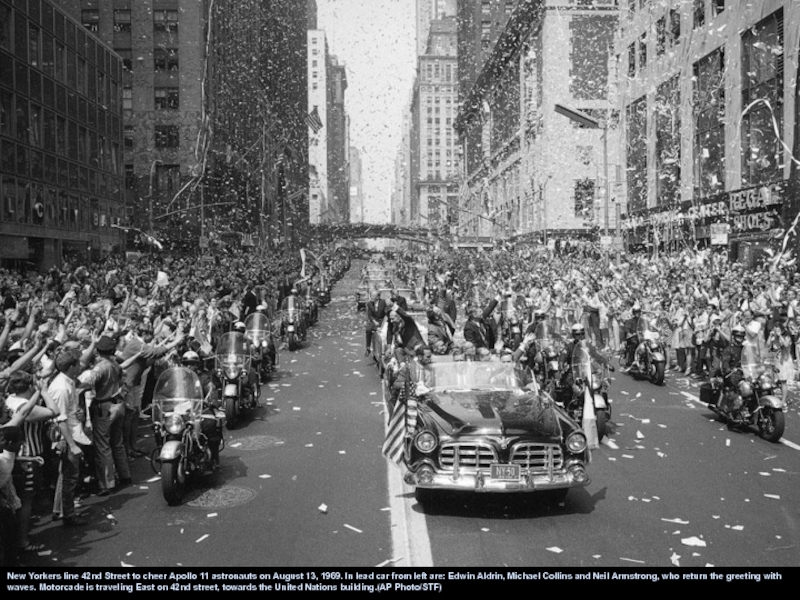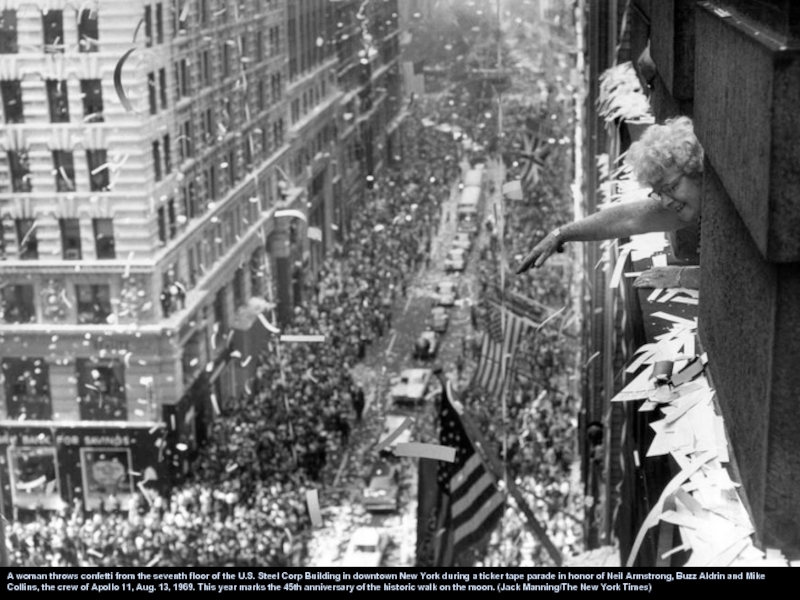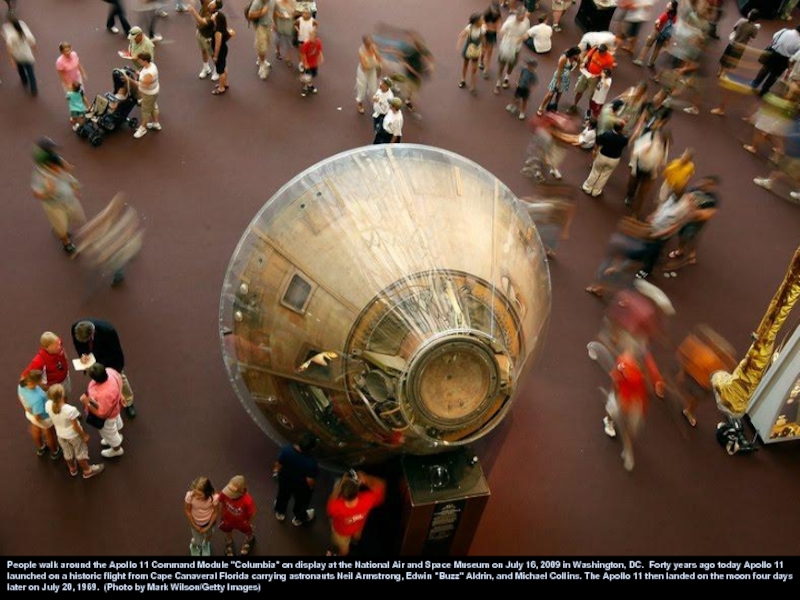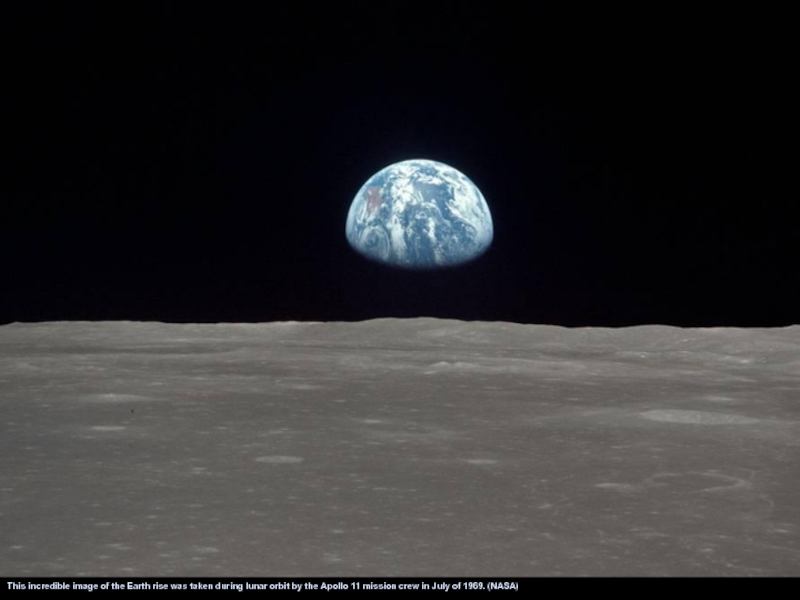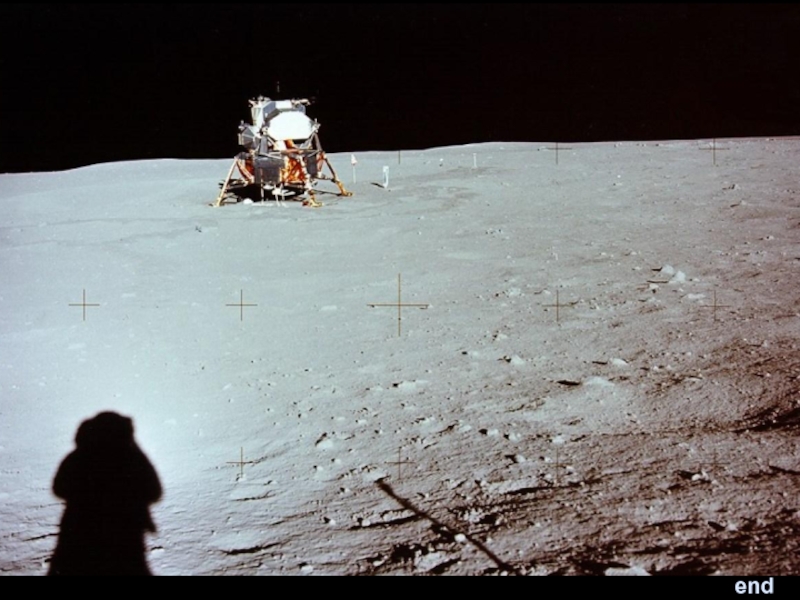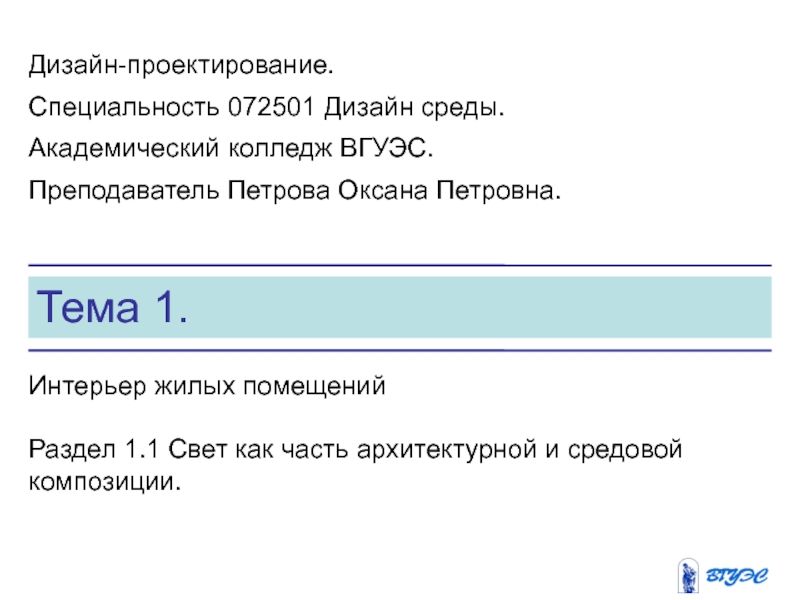- Главная
- Разное
- Дизайн
- Бизнес и предпринимательство
- Аналитика
- Образование
- Развлечения
- Красота и здоровье
- Финансы
- Государство
- Путешествия
- Спорт
- Недвижимость
- Армия
- Графика
- Культурология
- Еда и кулинария
- Лингвистика
- Английский язык
- Астрономия
- Алгебра
- Биология
- География
- Детские презентации
- Информатика
- История
- Литература
- Маркетинг
- Математика
- Медицина
- Менеджмент
- Музыка
- МХК
- Немецкий язык
- ОБЖ
- Обществознание
- Окружающий мир
- Педагогика
- Русский язык
- Технология
- Физика
- Философия
- Химия
- Шаблоны, картинки для презентаций
- Экология
- Экономика
- Юриспруденция
45th Anniversary of Apollo 11 Moon Landing презентация
Содержание
- 6. 45th Anniversary of Apollo 11 Moon Landing
- 7. The National Aeronautics and Space Administration (NASA)
- 8. In this photo provided by the Smithsonian
- 9. On July 20, 1969, Apollo 11 astronauts
- 10. In this photograph, Apollo 11 astronauts Edwin
- 11. The space crew of the Apollo 11
- 12. The Apollo 11 flight crew are given
- 13. In preparation of the nation's first lunar
- 14. Aboard a Saturn V launch vehicle, the
- 15. A technician works atop the white room,
- 16. Aerial view of the Saturn V rocket
- 17. A pre-launch twilight photo of the The
- 18. Chief astronaut and director of flight crew
- 19. Apollo 11 Commander Neil A. Armstrong waves
- 20. Neil Armstrong waving in front, and the
- 21. This is a view of a roadway
- 22. Every console was manned in firing room
- 23. Here are some of the thousands of
- 24. Spectators look on as Apollo 11, carrying
- 25. NASA photo taken on July 16, 1969
- 26. Launch of Apollo 11, on July 16,
- 27. The American flag heralds the flight of
- 28. Apollo 11 launch as viewed from an Air Force EC-135N plane. (NASA)
- 29. Vice President Spiro Agnew and former President
- 30. In this July 1969 file photo, most
- 31. View of lunar module and Earth beyond during the three-day coast to the Moon. (NASA)
- 32. In this July 20, 1969 file photo,
- 33. Newsmen talked with the wife and sons
- 34. An oblique of the Crater Daedalus on
- 35. View from LM (Armstrong's window) of craters Messier & Messier A. (NASA)
- 36. Interior view of the Apollo 11 Lunar
- 37. The Apollo 11 Lunar Module (LM) "Eagle",
- 38. A family watches the American astronaut Neil
- 39. Overall view of the Mission Operations Control
- 40. In this July 20, 1969 file photo,
- 41. This photo, from NASA TV, shows one
- 42. Apollo 11 astronaut Neil Armstrong steps on
- 43. Neil Armstrong's first photo, after setting foot on the Moon, on July 20, 1969. (NASA)
- 44. The deployment of the flag of the
- 45. A close-up view of an astronaut's foot
- 46. One of the first steps taken on
- 47. Shallow crater near Lunar Module. (NASA)
- 48. Buzz Aldrin's shadow and a bleak lunar landscape. (NASA)
- 49. Armstrong takes a photo of the landing site from a distance. (NASA)
- 50. In this July 20, 1969 file photo,
- 51. Astronaut Buzz Aldrin, lunar module pilot of
- 52. In this July 1969 file photo, Astronaut
- 53. The deployment of scientific experiments by Astronaut
- 54. Astronaut Buzz Aldrin, lunar module pilot, walks
- 55. This July 20, 1969 file photo released
- 56. Astronaut Buzz Aldrin carries experiments for deployment. (NASA)
- 57. Aldrin assembles the Passive Seismic Experiment Package, a device left to measure moonquakes. (NASA)
- 58. Neil Armstrong works at the LM
- 59. Lunar module ascent stage, still on the Moon's surface, with Earth seen overhead. (NASA)
- 60. Lunar module ladder and commemorative plaque. The
- 61. On July 20, 1969, Apollo 11 astronauts
- 62. The flag of the United States stands
- 63. After liftoff from the Moon, the lunar
- 64. Earth grows larger in the windows of
- 65. Flight controllers during lunar module descent
- 66. Apollo 11 crew boarding
- 67. Pararescueman Lt. Clancy Hatleberg closes the Apollo
- 68. U.S. President Richard Nixon Watches the recovery
- 69. The Mission Operations Control Room in the
- 70. President Richard Nixon views the Apollo 11
- 71. The Apollo 11 mission, the first manned
- 72. Apollo 11 astronauts, still in their quarantine
- 73. New York City welcomes the Apollo 11
- 74. New Yorkers line 42nd Street to cheer
- 75. A woman throws confetti from the seventh
- 76. People walk around the Apollo 11 Command
- 77. This incredible image of the Earth rise
- 78. end cast
Слайд 7The National Aeronautics and Space Administration (NASA) named three astronauts as
the prime crew of the Apollo 11 lunar landing mission. Left to right, are Neil A. Armstrong, commander; Michael Collins, command module pilot; and Edwin E. Aldrin Jr., lunar module pilot. (Photo by NASA/Newsmakers)
Слайд 8In this photo provided by the Smithsonian Institution, the Apollo 11
command module Columbia which carried astronauts Armstrong, Aldrin, and Collins to the Moon and back in July 1969 is seen at the National Air and Space Museum. (AP Photo/Smithsonian Institution, Eric Long)
Слайд 9On July 20, 1969, Apollo 11 astronauts Neil Armstrong and Edwin
“Buzz” Aldrin became the first men to walk on the moon after landing their lunar module. As he set foot on the lunar surface, Armstrong spoke his famous line, “That’s one small step for man, one giant leap for mankind.” Aldrin, who followed, described the scene as “magnificent desolation.” July 20, 2009 will be the 45th anniversary of the moon landing.
Слайд 10In this photograph, Apollo 11 astronauts Edwin (Buzz) Aldrin (left) and
Neil A. Armstrong prepare for the first Lunar landing as they practice gathering rock specimens during a geological field trip to the Quitman Mountains area near the Fort Quitman ruins in far west Texas. They used special lunar geological tools to pick up samples and place them in bags.Their practice paid off in July of the same year. The crew collected 47 pounds of lunar surface material which was returned to Earth for analysis. The lunar surface exploration was concluded in 2 1/2 hours. (NASA)
Слайд 11The space crew of the Apollo 11 mission sits in front
of cameras answering journalists questions during the night before the liftoff at Kennedy Space Center, Florida, on July 16, 1969. From left to right : Lunar module pilot Buzz Aldrin Jr, Commander Neil A. Armstrong, command module pilot Michael Collins. AFP PHOTO NASA (Photo credit should read /AFP/Getty Images)
Слайд 12The Apollo 11 flight crew are given instructions by technicians and
management while undergoing the Extravehicular Activity (EVA) training and the Lunar Module walk-through in preparation for the first manned landing on the Moon. (NASA)
Слайд 13In preparation of the nation's first lunar landing mission, Apollo 11
crew members underwent training to practice activities they would be performing during the mission. In this photograph, astronaut Edwin E. Aldrin, donned in his space suit, gets in more time under weightless conditions aboard a KC-135 aircraft from the Wright-Patterson Air Force Base. (NASA)
Слайд 14Aboard a Saturn V launch vehicle, the Apollo 11 mission launched
from The Kennedy Space Center, Florida on July 16, 1969 and safely returned to Earth on July 24, 1969. The space vehicle is shown here during the rollout for launch preparation. The 3-man crew aboard the flight consisted of Neil A. Armstrong, commander; Michael Collins, Command Module pilot; and Edwin E. Aldrin Jr., Lunar Module pilot. Armstrong was the first human to ever stand on the lunar surface, followed by Edwin (Buzz) Aldrin. The crew collected 47 pounds of lunar surface material which was returned to Earth for analysis. The surface exploration was concluded in 2 1/2 hours. With the success of Apollo 11, the national objective to land men on the Moon and return them safely to Earth had been accomplished. The Saturn V launch vehicle was developed by the Marshall Space Flight Center (MSFC) under the direction of Dr. Wernher von Braun. (NASA)
Слайд 15A technician works atop the white room, through which the astronauts
will enter the spacecraft, on July 11, 1969. (NASA)
Слайд 16Aerial view of the Saturn V rocket rollout for the Apollo
11 mission on May 20, 1969. (NASA)
Слайд 17A pre-launch twilight photo of the The Apollo 11 Saturn V
space vehicle. It lifted off July 16, 1969 from Kennedy Space Center in Florida. The space craft was injected into lunar orbit July 19, 1969 with Astronauts Neil A. Armstrong, Michael Collins and Edwin E. Aldrin Jr. on board. (Photo by NASA/Newsmakers)
Слайд 18Chief astronaut and director of flight crew operations, Donald K. Slayton
(right front) reviews lunar charts with Apollo 11 astronauts Michael Collins (left), Neil Armstrong, and Edwin Aldrin (next to Slayton) during breakfast a short time before the three men launched for the first Moon landing mission. Sharing breakfast with the crew was William Anders (left rear), Lunar Module pilot for the Apollo 8 lunar orbit mission. (NASA)
Слайд 19Apollo 11 Commander Neil A. Armstrong waves to well-wishers in the
hallway of the Manned Spacecraft Operations Building as he and Michael Collins and Edwin E. Aldrin Jr. prepare to be transported to Launch Complex 39A for the first manned lunar landing mission. (NASA)
Слайд 20Neil Armstrong waving in front, and the crew or Apollo 11,
head for the van that will take the crew to the rocket for launch to the moon at Kennedy Space Center in Merritt Island, Florida, on July 16, 1969. (AP Photo/File)
Слайд 21This is a view of a roadway near the NASA Kennedy
Space Center (KSC), shortly before dawn, where spectators from all over the world jammed into KSC to watch the liftoff of Apollo 11, the first manned lunar landing mission. (NASA)
Слайд 22Every console was manned in firing room 1 of the Kennedy
Space Flight Center (KSC) control center during the launch countdown for Apollo 11. (NASA)
Слайд 23Here are some of the thousands of persons who camped out
on beaches and roads adjacent to the Kennedy Space Center to watch the Apollo 11 Liftoff. (NASA)
Слайд 24Spectators look on as Apollo 11, carrying astronauts Neil Armstrong, Buzz
Aldrin and Mike Collins, takes off from the Kennedy Space Center, July 16, 1969. Four days later, Armstrong and Aldrin became the first men to walk on the moon. (Librado Romero/The New York Times)
Слайд 25NASA photo taken on July 16, 1969 shows the huge, 363-foot
tall Apollo 11 Spacecraft 107/Lunar Module S/Saturn 506) space vehicle launched from Pad A, Launch Complex 39. Kennedy Space Center (KSC), at 9:32 a.m. (EDT). Onboard the Apollo 11 spacecraft were astronauts Neil A. Armstrong, commander; Michael Collins, command module pilot; and Edwin E. Aldrin, Jr., lunar module pilot. Apollo 11 is the United States' first lunar landing mission. While astronauts Armstrong and Aldrin descended in the Lunar Module (LM) "Eagle" to explore the Sea of Tranquility region of the Moon, astronaut Collins remained with the Command and Service Modules (CSM) "Columbia" in lunar-orbit. (HO/AFP/Getty Images)
Слайд 26Launch of Apollo 11, on July 16, 1969. Fully fueled for
liftoff, the Saturn V weighed 2.8 million kilograms (6.2 million pounds) -- and generated 34.5 million newtons (7.6 million pounds) of thrust at launch. (NASA)
Слайд 27The American flag heralds the flight of Apollo 11, the first
Lunar landing mission. The Apollo 11 Saturn V space vehicle lifted off with astronauts Neil A. Armstrong, Michael Collins and Edwin E. Aldrin, Jr., at 9:32 a.m. EDT July 16, 1969, from Kennedy Space Center's Launch Complex 39A. During the planned eight-day mission, Armstrong and Aldrin would descend in a lunar module to the Moon's surface while Collins orbited overhead in the Command Module. The two astronauts were to spend 22 hours on the Moon, including two and one-half hours outside the lunar module. They would gather samples of lunar material and would deploy scientific experiments which would transmit data about the lunar environment. They would rejoin Collins in the Command Module for the return trip to Earth. (NASA)
Слайд 29Vice President Spiro Agnew and former President Lyndon Johnson view the
liftoff of Apollo 11 from the stands located at the Kennedy Space Center VIP viewing site. The Apollo 11 Saturn V Space Vehicle lifted off on July 16, 1969 and was injected into lunar orbit on July 19 with Astronauts Neil A. Armstrong, Michael Collins And Edwin E. Aldrin Jr., at 9:32am. The lunar module landed on the moon on July 20, 1969 and returned to the command module on July 21. (Photo By Nasa/Getty Images)
Слайд 30In this July 1969 file photo, most of Africa and portions
of Europe and Asia can be seen in this photograph taken from the Apollo 11 spacecraft during its translunar coast toward the moon, during the month of July, 1969. Apollo 11 was already about 98,000 nautical miles from earth when this picture was made. (AP-Photo/NASA, file)
Слайд 32In this July 20, 1969 file photo, the Apollo 11 lunar
module rises from the moon's surface for docking with the command module and the trip back to earth. The earth can be seen rising in the background. (AP Photo/NASA, file)
Слайд 33Newsmen talked with the wife and sons of Apollo 11 astronaut
Neil A. Armstrong after the successful launch of Apollo 11 on its trajectory to the moon. The Apollo 11 mission, the first lunar landing mission, launched from the Kennedy Space Center (KSC) in Florida via the Marshall Space Flight Center (MSFC) developed Saturn V launch vehicle on July 16, 1969 and safely returned to Earth on July 24, 1969. (NASA)
Слайд 34An oblique of the Crater Daedalus on the lunar farside as
seen from the Apollo 11 spacecraft in lunar orbit. The view looks southwest. Daedalus (formerly referred to as I.A.U. Crater No. 308) is located at 179 degrees east longitude and 5.5 degrees south latitude. Daedalus has a diameter of about 50 statute miles. This is a typical scene showing the rugged terrain on the farside of the Moon. While astronauts Neil A. Armstrong, commander, and Edwin E. Aldrin, Jr., lunar module pilot, descended in the Lunar Module (LM) "Eagle" to explore the Sea of Tranquility region of the Moon, astronaut Michael Collins, command module pilot, remained with the Command and Service Modules (CSM) "Columbia" in lunar orbit. (NASA)
Слайд 36Interior view of the Apollo 11 Lunar Module showing Astronaut Edwin
E. Aldrin, Jr., lunar module pilot, during the lunar landing mission. This picture was taken by Astronaut Neil A. Armstrong, commander, prior to the moon landing. (NASA)
Слайд 37The Apollo 11 Lunar Module (LM) "Eagle", in a landing configuration
is photographed in lunar orbit from the Command and Service Modules (CSM) "Columbia". Inside the LM were Commander, Neil A. Armstrong, and Lunar Module Pilot Edwin E. "Buzz" Aldrin Jr. The long "rod-like" protrusions under the landing pods are lunar surface sensing probes. Upon contact with the lunar surface, the probes send a signal to the crew to shut down the descent engine. (NASA)
Слайд 38A family watches the American astronaut Neil Armstrong, commander of Apollo
11, setting his foot on the moon on July 21, 1969 in Paris. Hundred of millions of television viewers round the world watched this event on television. (Photo credit should read AFP/Getty Images)
Слайд 39Overall view of the Mission Operations Control Room in the Mission
Control Center, bldg 30, Manned Spacecraft Center (MSC), showing the flight controllers celebrating the successful conclusion of the Apollo 11 lunar landing mission; NASA and MSC Officials join the flight controllers in celebrating the conclusion of the Apollo 11 mission. (NASA)
Слайд 40In this July 20, 1969 file photo, a crowd watches as
the Apollo 11 crew lands on the moon, on giant video screens in Central Park, New York. (AP Photo/Marty Lederhandler, file)
Слайд 41This photo, from NASA TV, shows one of the Apollo 11
astronauts on the lunar surface after landing from a new digitally refurbished version of the original moon landing video unveiled in Washington on Thursday, July 16, 2009. After NASA couldn't find its original videotapes, NASA and a Hollywood film restoration company took television video copies of what Apollo 11 beamed to Earth on July 20, 1969, and made the pictures look sharper. (AP Photo/NASA TV)
Слайд 42Apollo 11 astronaut Neil Armstrong steps on surface of the moon
on July 20, 1969. (AP Photo)
Слайд 44The deployment of the flag of the United States on the
surface of the Moon is captured on film during the first Apollo 11 lunar landing mission. Here, astronaut Neil A. Armstrong, commander, stands on the left at the flag's staff. Astronaut Edwin E. Aldrin, Jr., lunar module pilot, is also pictured. The picture was taken from film exposed by the 16mm Data Acquisition Camera (DAC) which was mounted in the Lunar Module (LM). While astronauts Armstrong and Aldrin descended in the Lunar Module (LM) "Eagle" to explore the Sea of Tranquility region of the Moon, astronaut Michael Collins, command module pilot, remained with the Command and Service Modules (CSM) "Columbia" in lunar-orbit. (NASA)
Слайд 45A close-up view of an astronaut's foot and foot print in
the lunar soil is photographed with a 70mm lunar surface camera July 20, 1969 during the Apollo 11 lunar surface extravehicular activity (EVA). (Photo by NASA/Newsmakers)
Слайд 46One of the first steps taken on the Moon, this is
an image of Buzz Aldrin's bootprint from the Apollo 11 mission. (NASA)
Слайд 50In this July 20, 1969 file photo, Astronaut Neil A. Armstrong,
Apollo 11 commander, is seen inside the Lunar Module while the LM rested on the lunar surface. Astronauts Armstrong and Edwin E. Aldrin Jr., lunar module Pilot, had already completed their extravehicular activity when this picture was made. (AP Photo/NASA, file)
Слайд 51Astronaut Buzz Aldrin, lunar module pilot of the first lunar landing
mission, poses for a photograph beside the deployed United States flag during an Apollo 11 Extravehicular Activity (EVA) on the lunar surface. The Lunar Module (LM) is on the left, and the footprints of the astronauts are clearly visible in the soil of the Moon. Astronaut Neil A. Armstrong, commander, took this picture with a 70mm Hasselblad lunar surface camera. While astronauts Armstrong and Aldrin descended in the LM, the "Eagle", to explore the Sea of Tranquility region of the Moon, astronaut Michael Collins, command module pilot, remained with the Command and Service Modules (CSM) "Columbia" in lunar-orbit. (NASA)
Слайд 52In this July 1969 file photo, Astronaut Edwin Aldrin walks by
the footpad of the Apollo 11 Lunar Module. (AP/Photo, NASA, file)
Слайд 53The deployment of scientific experiments by Astronaut Edwin Aldrin Jr. is
photographed by Astronaut Neil Armstrong. Man's first landing on the Moon occurred July 20, 1969 as Lunar Module "Eagle" touched down gently on the Sea of Tranquility on the east side of the Moon.(Photo by NASA/Newsmakers)
Слайд 54Astronaut Buzz Aldrin, lunar module pilot, walks on the surface of
the Moon near the leg of the Lunar Module (LM) "Eagle" during the Apollo 11 exravehicular activity (EVA). Astronaut Neil A. Armstrong, commander, took this photograph with a 70mm lunar surface camera. While astronauts Armstrong and Aldrin descended in the Lunar Module (LM) "Eagle" to explore the Sea of Tranquility region of the Moon, astronaut Michael Collins, command module pilot, remained with the Command and Service Modules (CSM) "Columbia" in lunar orbit. (NASA)
Слайд 55This July 20, 1969 file photo released by NASA shows Apollo
11 astronaut Edwin E. "Buzz" Aldrin, Jr. removing a scientific experiment from the Lunar Module "Eagle" during the Apollo 11 lunar landing mission. As an estimated 500 million people around the world waited with bated breath crowded around fuzzy television screens and radios, Armstrong stepped down the lunar module's ladder and onto the lunar surface. "That's one small step for man, one giant leap for mankind," Armstrong intoned, his words slightly distorted by distance and communications equipment, in a phrase now etched forever into the history books. (/AFP/Getty Images)
Слайд 57Aldrin assembles the Passive Seismic Experiment Package, a device left to
measure moonquakes. (NASA)
Слайд 60Lunar module ladder and commemorative plaque. The plaque reads: "Here men
from the planet Earth first set foot upon the Moon July 1969, A.D. We came in peace for all mankind." (NASA)
Слайд 61On July 20, 1969, Apollo 11 astronauts Neil Armstrong and Edwin
"Buzz" Aldrin became the first to walk on the Moon. This panorama of their landing site sweeps across the magnificent desolation of the Moon's Sea of Tranquility, with their Lunar Module, the Eagle, in the background at the far left. East Crater, about 30 meters wide and 4 meters deep, is on the right, and was so named because it is about 60 meters east of the Lunar Module. Armstrong had piloted the Eagle safely over the crater. Near the end of his stay on the lunar surface, Armstrong strayed far enough from the Lunar Module to take the pictures used to construct this wide-angle view, his shadow appearing at the panorama's left edge. The object near the middle foreground is a stereo close-up camera. (NASA)
Слайд 62The flag of the United States stands alone on the surface
of the moon. (Photo by NASA/Newsmakers)
Слайд 63After liftoff from the Moon, the lunar module approaches CSM for
docking, with earthrise in background. (NASA)
Слайд 64Earth grows larger in the windows of the Command Module Columbia
during the return trip of Apollo 11. (NASA)
Слайд 66
Apollo 11 crew boarding a recovery helicopter after a
successful splashdown on July 24, 1969. (AP Photo)
Слайд 67Pararescueman Lt. Clancy Hatleberg closes the Apollo 11 spacecraft hatch as
astronauts Neil Armstrong, Michael Collins, and Buzz Aldrin, Jr., await helicopter pickup from their life raft. They splashed down at 12:50 pm EDT July 24, 1969, 900 miles southwest of Hawaii after a successful lunar landing mission. (NASA)
Слайд 68U.S. President Richard Nixon Watches the recovery of the Apollo 11
crew from aboard the USS Hornet in the Pacific Ocean, some 900 miles south of Hawaii, July 24, 1969. At left is astronaut Frank Borman, who commanded Apollo 8. (NASA via The New York Times)
Слайд 69The Mission Operations Control Room in the Mission Control Center, showing
flight controllers celebrating the successful conclusion of the Apollo 11 lunar landing mission on July 24 1969. (NASA)
Слайд 70President Richard Nixon views the Apollo 11 astronauts in the isolation
unit aboard the USS Hornet after splashdown and recovery, July 24, 1969. The Astronauts, from left, are: Neil Armstrong, Michael Collins and Buzz Aldrin. (AP photo)
Слайд 71The Apollo 11 mission, the first manned lunar mission, launched from
the Kennedy Space Center, Florida via the Marshall Space Flight Center (MSFC) developed Saturn V launch vehicle on July 16, 1969 and safely returned to Earth on July 24, 1969. Aboard the space craft were astronauts Neil A. Armstrong, commander; Michael Collins, Command Module (CM) pilot; and Edwin E. (Buzz) Aldrin Jr., Lunar Module (LM) pilot. The recovery operation took place in the Pacific Ocean where Navy para-rescue men recovered the capsule housing the 3-man Apollo 11 crew. The crew was airlifted to safety aboard the U.S.S. Hornet, where they were quartered in a Mobile Quarantine Facility (MQF) which served as their home until they reached the NASA Manned Spacecraft Center (MSC) Lunar Receiving Laboratory in Houston, Texas. On arrival at Ellington Air Force base near the MSC, the crew, still under a 21 day quarantine in the MQF, were greeted by their wives. Pictured here is Joan Aldrin, wife of Buzz Aldrin, speaking with her husband via telephone patch. (NASA)
Слайд 72Apollo 11 astronauts, still in their quarantine van, are greeted by
their wives upon arrival at Ellington Air Force Base on July 27, 1969
Слайд 73New York City welcomes the Apollo 11 crew in a showering
of ticker tape down Broadway and Park Avenue August 13, 1969. Pictured in the lead car, from the right, are astronauts Neil A. Armstrong, commander; Michael Collins, command module pilot; and Edwin E. Aldrin Jr., lunar module pilot. The three astronauts teamed for the first manned lunar landing on July 20, 1969. (Photo by NASA/Newsmakers)
Слайд 74New Yorkers line 42nd Street to cheer Apollo 11 astronauts on
August 13, 1969. In lead car from left are: Edwin Aldrin, Michael Collins and Neil Armstrong, who return the greeting with waves. Motorcade is traveling East on 42nd street, towards the United Nations building.(AP Photo/STF)
Слайд 75A woman throws confetti from the seventh floor of the U.S.
Steel Corp Building in downtown New York during a ticker tape parade in honor of Neil Armstrong, Buzz Aldrin and Mike Collins, the crew of Apollo 11, Aug. 13, 1969. This year marks the 45th anniversary of the historic walk on the moon. (Jack Manning/The New York Times)
Слайд 76People walk around the Apollo 11 Command Module "Columbia" on display
at the National Air and Space Museum on July 16, 2009 in Washington, DC. Forty years ago today Apollo 11 launched on a historic flight from Cape Canaveral Florida carrying astronauts Neil Armstrong, Edwin "Buzz" Aldrin, and Michael Collins. The Apollo 11 then landed on the moon four days later on July 20, 1969. (Photo by Mark Wilson/Getty Images)
Слайд 77This incredible image of the Earth rise was taken during lunar
orbit by the Apollo 11 mission crew in July of 1969. (NASA)
Слайд 78
end
cast
45th Anniversary of Apollo 11 Moon Landing
images credit www. Music Vangelis
created olga.e. thanks for watching
images credit www. Music Vangelis
created olga.e. thanks for watching
